



SHIFTING SANDS IN ASIA




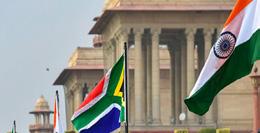

ENABLED FEBRUARY EDITION 2024 | MONTHLY EDITION LOOKING BEYOND THE CURVE SYNERGIA “ASIA 2035: TOWARDS AN ASIAN EPOCH?” Page - 03 INDO-PACIFIC CHALLENGES Page - 17 TRUSTWORTHY AI Page - 28 STIRRING UP OF BLOOD TIES! Page - 35 Page - 48 BUDGETING FOR GROWTH EXCLUSIVES
MEDIA


INSIGHTS is a strategic affairs, foreign policy, science and technology magazine that provides nonpartisan analysis of contemporary issues based on real-time information.
To subscribe,
sambratha@synergiagroup.in ; +91 80 4197 1000

https://www.synergiafoundation.org
EDITORIAL
Dear Reader:
Greetings from the Synergia Foundation!
The Spotlight story of this month analyses the facts and fiction of the ‘Asian Century.’ Any discussion on this subject will invariably lead to comparing the Chinese model with India’s growth story. We have selected a galaxy of neutral analysts to get an objective view and put the subject in the correct perspective.
In our regular coverage of India’s neighbourhood, we have graduated from the immediate neighbourhood to the extended one since the last few issues. This time, we lead with the Indian viewpoint on the naval dimensions of the Indo-Pacific as articulated by the Chief of Naval Staff of the Indian Navy. We also look at the growing Indo-Japanese partnership, as seen by the Synergia Foundation during a recent Quad interaction hosted by Japan.
As always, technology remains a core subject for Synergia Foundation and finds a reflection in all our activities and publications. This issue is no exception, and we seek the views of practitioners of


security (defence, economic, cyber, etc) to pen down their insights on their respective fields of expertise. We look at the new domains of warfare generated by technology and do a detailed vivisection of artificial intelligence in all its dimensions: legal, warfare, etc.
In our global scan, we look at global strategic trends. In this segment, we are starting a new series focusing on Africa. We start with what it means for India to reach out to the African continent at large, and with South Africa being one of the most significant nations of the region, the Republic of South Africa is the focus.
This month’s geopolitics basket has an overview of the recently concluded elections in Taiwan and a detailed insight into the Red Sea embroglio. We end with an analysis of the recent interim Indian budget.
We hope our esteemed readers will continue supporting us as we strive to further evidence-based research on strategic issues with global resonance.
Sincerely yours

 Maj. Gen. Ajay Sah Chief Information Officer
Maj. Gen. Ajay Sah Chief Information Officer
 SCAN THE QR CODE TO SUBSCRIBE
SCAN FOR FEEDBACK
SCAN THE QR CODE TO SUBSCRIBE
SCAN FOR FEEDBACK

FEATURED


“ASIA 2035: TOWARDS AN ASIAN EPOCH?”
Markets and technology will play a critical role in this region, largely because of the great population centres that exist here.
PAGE 03

ASIA’S RISE TO GLOBAL DOMINANCE
An Asian century, which is still a way off, will require the cooperation of both China and India.
PAGE 06
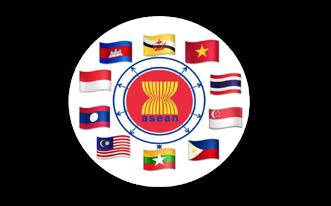
ASIA UNLEASHED: THE POWER PLAY BEGINS
For China to define the Asian century, domination over Asia is essential.
PAGE 08

2035: PEERING INTO INDIA’S ECONOMIC FUTURE
Given the tumultuous geopolitical landscape, what does 2035 hold for the Indian economy?
INDIA’S EXTENDED NEIGHBOURHOOD

PAGE 12
INDO-PACIFIC CHALLENGES
Indo-Pacific is a natural region where the destinies of constituent nations are deeply interlinked.
SUSHI AND SPICES: DECODING THE INDO-JAPAN ALLIANCE
The India-Japan partnership extends beyond bilateral ties, finding expression in trilateral arrangements and the Quad framework.

PAGE 17

PAGE 21
SECURITY
NEW LAND OPERATIONS
Future conflicts will probably be more complex, more lethal and more contested.
PAGE 23
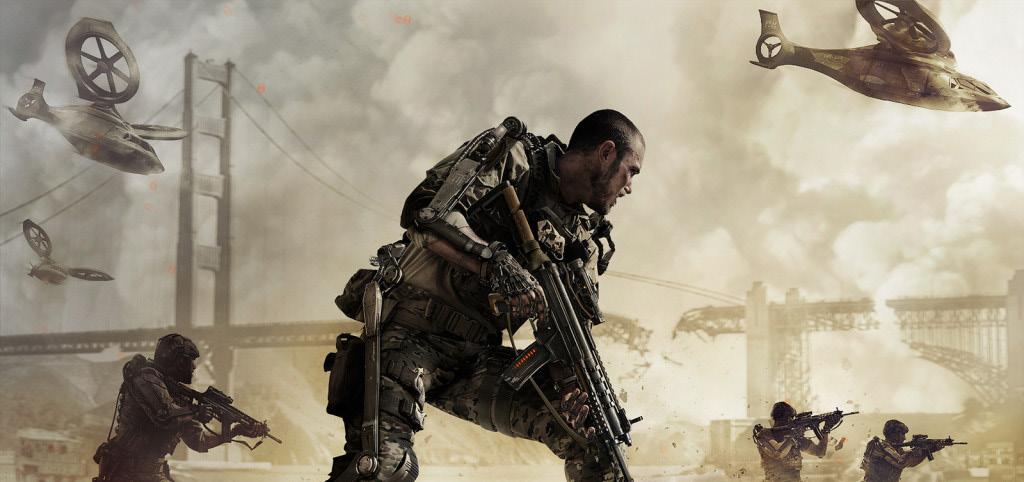
WARFARE AHEAD: CONFRONTING FUTURE CHALLENGES
PAGE 24
TECHNOLOGY
ALGORITHMIC WARFARE: AI’S PROMISE & BOUNDARIES
As far as risk mitigation is concerned, there is no one-size-fits-all solution.
PAGE 26

TRUSTWORTHY AI
As far as risk mitigation is concerned, there is no one-size-fits-all solution.
PAGE 28

AI AND THE LAW: WHERE PATHS COLLIDE
New technologies, however impressive, will never eliminate the fog, friction, and chaos of war.
GLOBAL SCAN
GLOBAL TRENDS: TRANSFORMING TOMORROW
“For the first time, we are looking at the potential for global conflict on a scale of World War II.”
PAGE 33
STIRRING UP OF BLOOD TIES!
PAGE 29

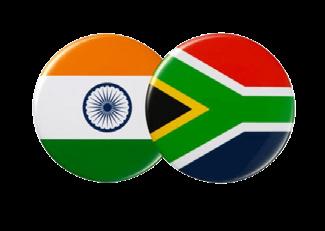
The Indian diaspora in South Africa is undeniable, but do they have the bandwidth to act as a bridge with their mother country?
PAGE 35
GEOPOLITICS
TAIWAN ELECTIONS: TAKING A COUNT
An emboldened Lai Ching-te asserts Taiwanese sovereignty but remains short of claiming a formal declaration of independence.
PAGE 42
ECONOMICS
BUDGETING FOR GROWTH
India’s interim budget has laid out the roadmap for growth by signalling an investment boost, tax relief and key measures for focus groups.
REACHING OUT TO AFRICA
India needs to frame its African strategy through an Indian lens.
PAGE 39
TURNING RED
The Red Sea has become an arena of conflict between David and Goliath with international repercussions.
PAGE 45

HEALTH CARE

QUAD: TRANSFORMING GLOBAL HEALTH
PAGE 51
Future conflicts will probably be more complex, more lethal and more contested.
` SPOTLIGHT STORY : MAPPING TRAJECTORY OF ASIA 2035
The multifaceted dimensions of Quad are highlighted by its efforts to transform global health by overcoming paradoxes and embracing innovations.

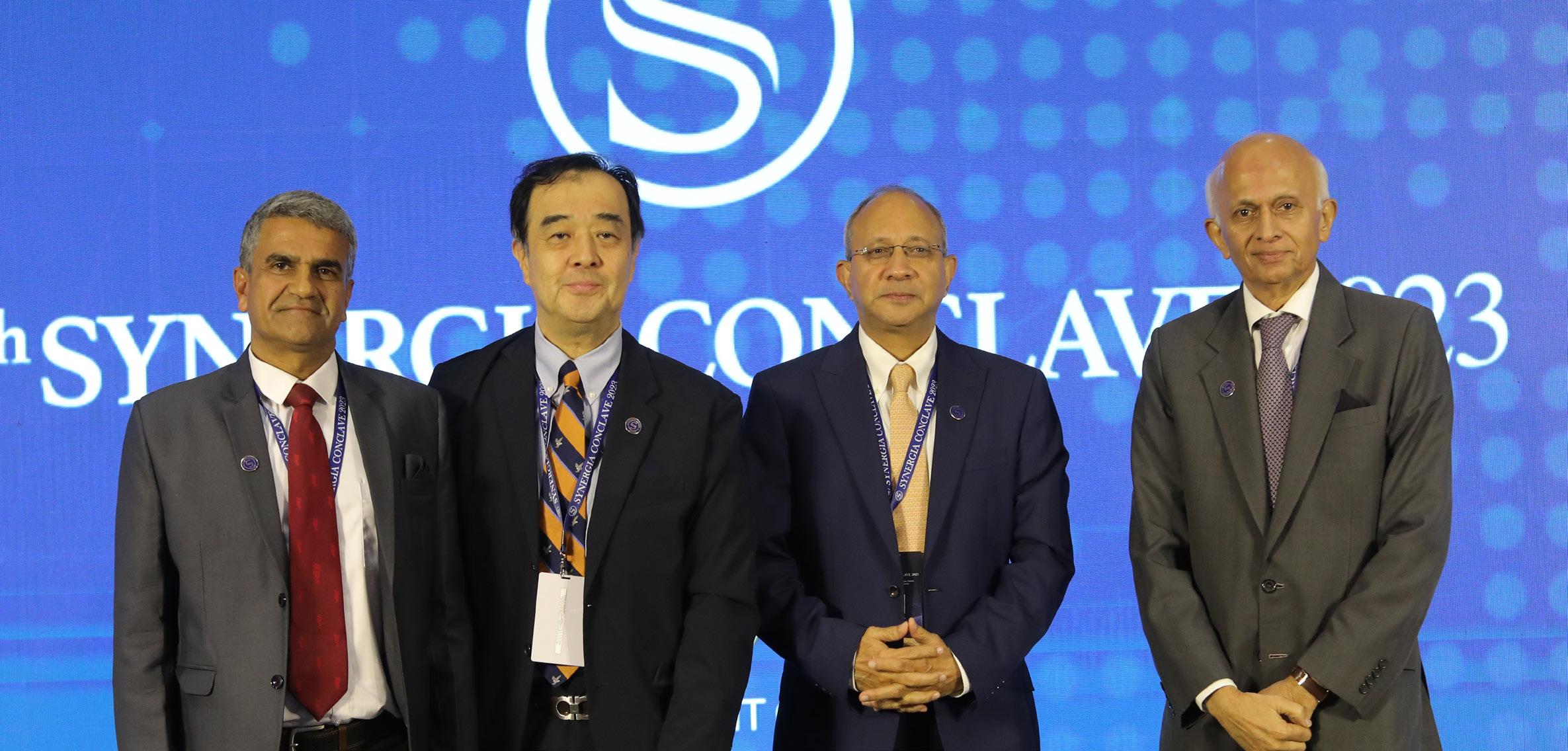
“ASIA 2035: TOWARDS AN ASIAN EPOCH?”


Markets and technology will play a critical role in this region, largely because of the great population centres that exist here.
It is fashionable to call this the ‘Asian Century.’ But amidst all the optimism lie embedded niggling doubts.
In light of the recent transformational events that have taken place, does the concept of the Asian Century still hold true? Is economic heft sufficient for Asia to claim the Century? And more importantly, what are the key drivers or factors that will impact the trajectory of Asia over the next 10 to 15 years? And finally, what are the plausible scenarios that could emerge for Asia by 2035?
2035 is not very far away by historical standards; it is just 13 years away from now. Because in the last ten years, India’s GDP has doubled, a 10–12-year period is not a particularly long period.
UNIPOLAR ASIA?
The base case scenario for the Asian Century is an Asia that China dominates. Any other scenario would be an aberration and somewhat of a Black Swan event. Despite the difficulties that the Chinese economy faces, almost all predictions about China’s growth and GDP are pretty uniform, putting China at a GDP of about $50
The rise of India will be a major factor in how China and India handle each other and live with each other in such an Asian Century. China and India face challenges, but how much of this will lead to unipolar or multipolar Asia is also a question that seeks answers.
trillion by 2035, the United States at $36 trillion, and India at about $10 trillion.
The question then becomes whether we are talking of an Asian or Chinese century. What might unfold is that possibly, for the first time, a global power that is resident in Asia and not in Europe or North America. And this will have major implications for the security architecture of the entire region.
Will China be an interventionist power like the United States or the erstwhile Soviet Union, or will it take a different shape and form regarding global institutions? The BRI and successor programmes indicate an alternative approach, both to the consolidation of power within and consolidation of power without.
The second question that arises is whether Asia is amenable to a security architecture in the form that we have seen in Europe and in the transatlantic alliance or earlier during the Soviet times of the Warsaw Pact. The prognosis for an Asia security architecture is still highly bleak.
SYNERGIA CONCLAVE 2023
This
article is based
on the round table curated
by
Ambassador Pankaj Saran, Member (NSAB) & Former Deputy National Security Advisor India, on the Trajectory of Asia 2035 at the 9th Synergia Conclave 2023.

There are serious identity issues. While the focus may be on East Asia, the fact is that multiple Asias impact the security architecture- West Asia, Central Asia and South Asia. And the question is whether with a China-dominated Asia, what will be its influence over the non-East Asian parts of Asia.
Will there be a convergence of security perspectives within Asia, or will we continue to see fragmentation as evident in West Asia?
The rise of India will be a major factor in how China and India handle each other and live with each other in such an Asian Century. China and India face challenges, but how much of this will lead to unipolar or multipolar Asia is also a question that seeks answers.
If we go by the base case scenario of an Asia dominated by China, we are heading towards a unipolar Asia. If that is the case, what would be the responses from the residential powers and powers outside Asia?
U.S. CHINA CONTESTATION
The world has witnessed different phases of the U.S.-China rivalry. However, as time passes, we will see more and more peer relationships between the two powers. In 2017, the United States national security strategy referred to China for the first time, and in the last six years, the U.S. national security approach to China has been informed by this new paradigm of major power relationships.
As a consequence of this big power rivalry, a certain degree of hedging and uncertainty will exist among the middle powers of Asia. Here the role of India could become critical in terms of offering choices to other Asian countries in values, systems, institutions, etc.
Markets and technology will play a critical role in this region, largely because of the great population centres that exist here. India will be a huge market by 2035. The question is whether production can be democratised and manufacturing centres created outside China.
Technology will be a critical driver of influence; a technological race is underway, which will impact Asia as it will impact the rest of the world.
If China is the dominant major global power, then the lines between Asia and Europe or Asia and other continents will likely blur. So, can other Asian countries claim a stake in the so-called Asian Century? If yes, then what is the space that they will occupy?
While the region has many fault lines, Taiwan could be critical. There is unlikely to be any conflagration over Taiwan till 2035 because all parties understand that any breakout of kinetic war in the region will be extremely disruptive and detrimental to China and other parties who might be forced into such a conflict.
AN ASIAN UNION?
Can Asian countries overcome all their differences and form an Asian union? The fact is that Asia remains as fragmented as it was many decades ago. There is a lack of Asian identity that will bring different sub-regions of Asia together to form some kind of a project or an organisation, as we have seen in Europe.
Paradoxically, the only initiative that seems to link Asia’s sub-regions is the Chinese BRI. There have been some studies on creating an Asian Monetary Fund, again a localised East Asian project spearheaded by the ASEAN. It does not command much consensus within the Asian region.
04 “ASIA 2035: TOWARDS AN ASIAN EPOCH?”

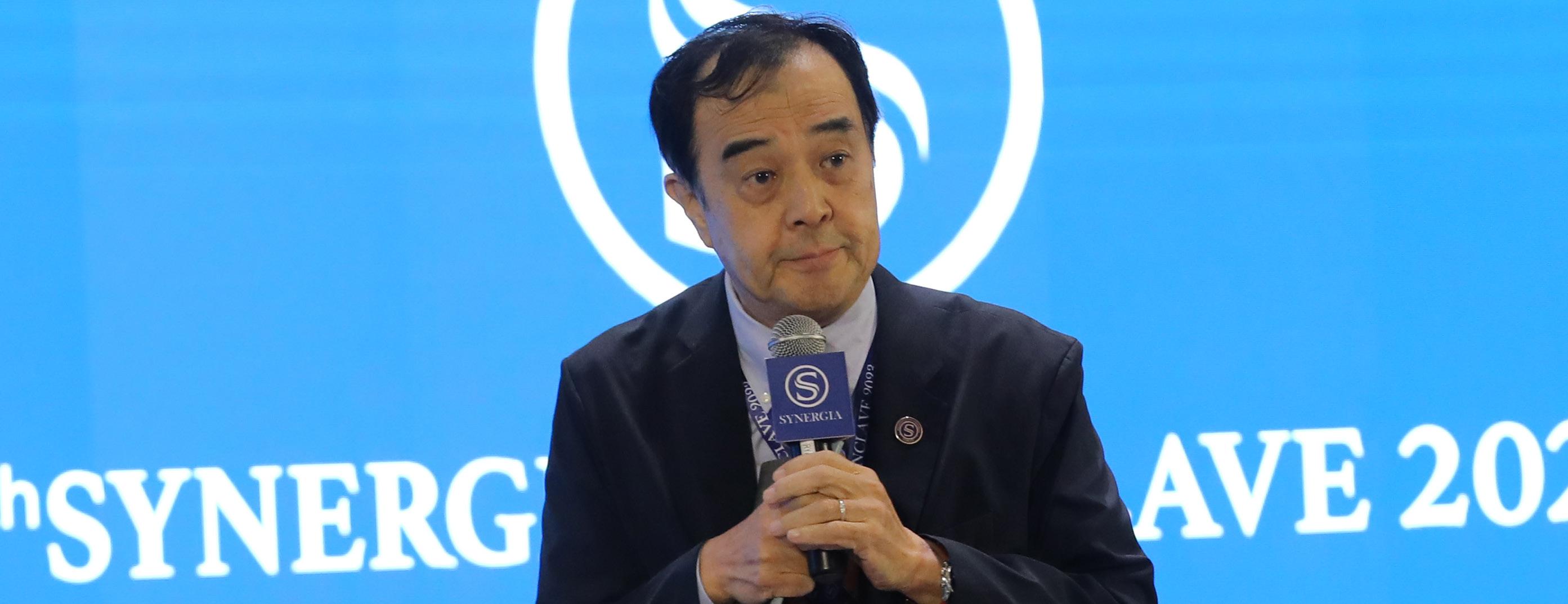 PROF KUNIHIKO MIYAKE Former advisor to the Prime Minister of Japan, special advisor to the Japanese Cabinet.
PROF KUNIHIKO MIYAKE Former advisor to the Prime Minister of Japan, special advisor to the Japanese Cabinet.
ASIA 2035
SCENARIOS FOR THE ASIAN CENTURY
When analysing the trajectory or power cascade for 2035, the key driver would be the U.S.-China relationship. The issues to be addressed in this context are the possibility of a US-China war and its winner or loser and the contributions India can make.
POSSIBLE SCENARIOS
If it is assumed that there will be no war before 2035, no winner and no loser, and a free and open Indo-Pacific will continue, then we are looking at the status quo. Does it mean then that there will be no century of Asia? Most would prefer this status quo.
But suppose war breaks out. Then there are three possibilities. Scenario ‘A’ means Americans will win, Scenario ‘B’ means China will win and Scenario ‘C’ means somewhere in between.
Scenario A: If America wins and China is badly defeated, China will not be left unimpacted- something has to give in either direction. Will they move towards democracy or become even more dictatorial?
Scenario B: There are two possibilities. If China wins, Americans may leave the world stage. And that would create a huge vacuum that China may dominate. Here comes India’s contribution that could make a difference.
Scenario C: While America wins, the victory could be a pyrrhic one, leaving a deeply weakened America in its wake. This could leave East Asia extremely unstable.
There would be greater demand for an Indian contribution to stabilise the situation. Only fools learn from experience; the wise learn from history. In the 1930s, in East Asia and the Indo-Pacific region, there was a new rising power- powerful, nationalistic and very xenophobic-Imperial Japan. Perceiving America as a declining power, it sought to establish a new international order
of its own making. This rising power challenged American hegemony militarily in the Western Pacific; the rest is history. The greatest worry is that China should not walk into the same trap as Imperial Japan did in 1941 by attacking Pearl Harbour to challenge the status quo by force.
The Chinese assure us that they are not that stupid.
ECONOMY VERSUS SECURITY
The economy underscores security, but mistakes are made when there is a big gap between the thinking of the strategic thinkers and the economists. The economy is not a driver; the economy is the result because, without any stable national security situation, there will be no economic activity. To have security, sometimes we need an economy, but the economy results from perfect security arrangements.
For successful security arrangements, geopolitical dominance is a pre-requisite, but technology is needed to do that. So, disruptive technologies are extremely important. However, technology does not guarantee geopolitical dominance.
Japan is a good example, a highly sophisticated, advanced country of technology in the 60s and 70s, especially the 80s and 90s. Did it become a dominant geopolitical power? No. State-of-the-art technology should be applied to the battlefield. But if they are not applied to the battlefield, a real weapon system, you can never be a dominant power. Japan has never tried to do that because it is a peaceful nation. Its engineers or inventors have no idea how to apply those state-of-the-art technologies to military applications.
Israel is a different example; it talks about technological innovations day and night and their application to the weapon systems they use every day. Technology comes first to be a dominant power, but to do that, you should be able to apply those disruptive technologies to the battlefield. Then, you stabilise the situation to reach a comfortable level of security, which enables economic prosperity.
SYNERGIA CONCLAVE 2023

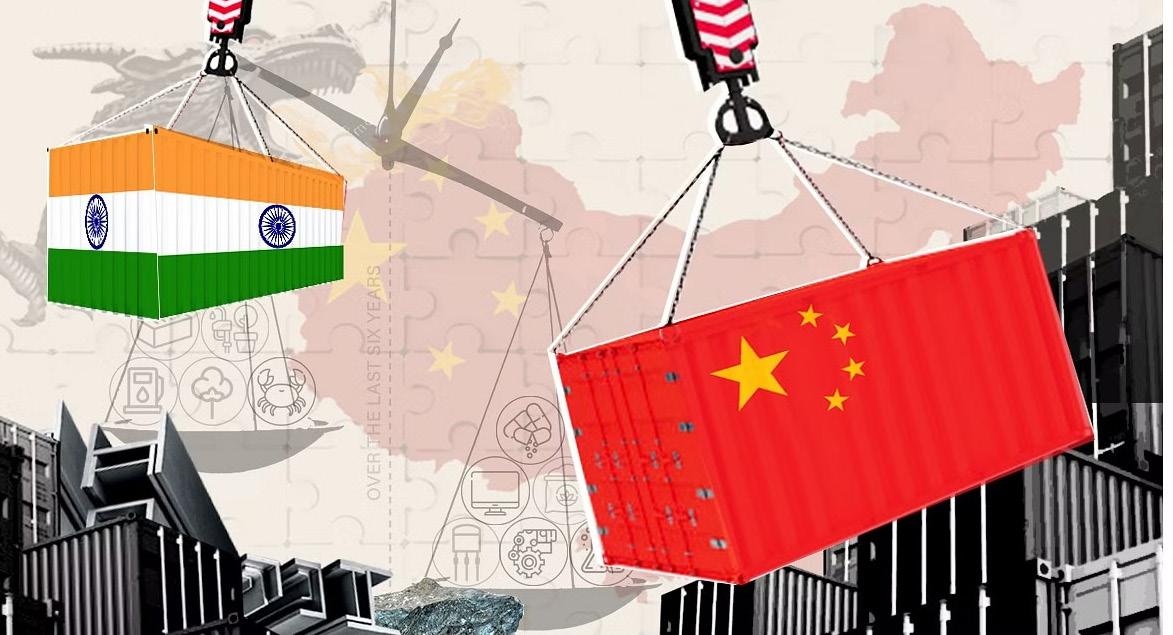


ASIA’S RISE TO GLOBAL DOMINANCE
An Asian century, which is still a way off, will require the cooperation of both China and India.
As per the database sampled by the late Angus Pedersen, a very distinguished economic historian, based on purchasing power parity internationally, in 1820, two centuries ago, China supposedly had accounted for more than 30 per cent of world GDP, and India accounted for perhaps between 20 and 25 per cent of global GDP. The U.S., being a new country then, had less than 3 per cent.
What has happened over the years is that by 1960, the U.S. accounted for over 30 per cent. And in the meantime, both China and India have declined. Around the 1960s or 1970s, both were at the bottom, fetching much less than 10 per cent. However, there has been a turnaround; by 2015, China, in purchasing power parity terms, reached parity with the U.S. This finding was confirmed by both the IMF and the World Bank. India also came up, but not by as much.
CHINA AND INDIA
It would take until 2033 before Chinese GDP, and market prices and market exchange rates catch up to the U.S., even though China has been growing faster than the U.S. for about half a century. India has also been doing well in terms of GDP growth, especially in the last decade or so. Indian growth rates in the last ten years have sometimes been even higher than Chinese growth rates, and

East Asia is higher than the USA now. In 2070, China and India would have a GDP of perhaps half of the world’s GDP. India has very fine economic fundamentalsno shortage of primary inputs, tangible capital, labour and human capital. The Indian savings rate is quite healthy, around 30 per cent. India has enough savings with finances and investments.
it is assumed that India will continue to grow at 8.5 per cent. But even at these rates, it will not come too close to the Chinese or U.S. GDP.
In terms of per capita, the gap is big even for China. Even when China reached parity with U.S. GDP, for per capita, China was only one quarter that of US GDP, and it would take at least until the end of this century, if at all, for Chinese GDP per capita to surpass that of U.S. GDP. India, there’s a similar story, just a little bit further displaced in terms of time. India will become a huge economy probably sometime around 2060, maybe 2070.
While the U.S. share of the global GDP has been steadily declining even though it is about 50 per cent today, the Chinese has been going up along with India. Japan peaked at about 18 per cent of the global GDP in the early 1990s and has since been coming down. India is rising, although not enough to make a difference right now. East Asia is higher than the USA now. In 2070, China and India would have a GDP of perhaps half of
SYNERGIA CONCLAVE 2023
This article is based on the round table curated by Prof Lawrence Lau on Trajectory of Asia 2035 at the 9th Synergia Conclave 2023.
WHEN THE WORLD’S ‘BACK OFFICE’ MEETS WITH THE WORLD’S ‘FACTORY’ ...

the world’s GDP. India has very fine economic fundamentals- no shortage of primary inputs, tangible capital, labour and human capital. The Indian savings rate is quite healthy, around 30 per cent. India has enough savings with finances and investments.
INDIA
Labour supply in India should not be a problem. India is now the world’s largest population and has a younger population than China. It has a highly educated labour force and an ample supply of engineers and scientists. And like China, India enjoys tremendous economies of scale.
And because of its large population, it has a very large number of very smart people. India needs to construct an infrastructure to link the whole country together to realize its economies of scale. It should, therefore, invest in developing leading infrastructure that will create its own demand.
India should also have a strong export promotion strategy. As India expands its manufacturing, it will create employment and boost trade. India does not have a single unified language, but it can rely on English for communication. Corruption per se should not be an obstacle in itself. As you read about it in papers, corrupt senior officials are uncovered in China almost every day. So, even when people complain about possible corruption in India, that alone should not be an obstacle to growth.
SOUTH ASIA
A South Asian Free Trade Zone can be very positive for India and South Asia. Taking India, Pakistan, Bhutan, Sri Lanka, Nepal, and Bangladesh together would amount to a population of around 1.9 billion, a quarter
of the world population. And if SAFTA is created, a mini form of economic globalisation will benefit every member of the world. SAFTA will be able to do the same for South Asia as the European common market did for post-World War 2 Western Europe. That is, maintain peace and prosper together. For instance, Germany fought three wars in the nineteenth and twentieth centuries. The common market provided the bond that tied them together; economic interdependence is a great way to prevent conflict between nations.
GEOPOLITICAL FACTORS
Peace in South Asia is positive; lack of peace is negative. Peace in Taiwan’s straits is positive; the lack of it is negative. China-U.S. strategic competition is negative, and it continues. Despite what Graham Addison said, there will not be any war between China and the U.S. because there will not be any winners. Both countries will be losers. The former Soviet Union and the U.S. came to the same realisation and never went to war in the last century. They even had strategic arms control treaties. The same would eventually happen between China and the U.S.
The Bretton Woods system of settlement of international transactions in each country’s national currencies will be revived.
Globalisation, decoupling, and de-risking will all be initially difficult, but ultimately possible because of increased competition among the sup ply chain; competition will lower prices for all. There will be an Asian century, which is still a way off and will require the cooperation of both China and India.
PROF LAWRENCE LAU
Professor of Economic, University of Hong Kong
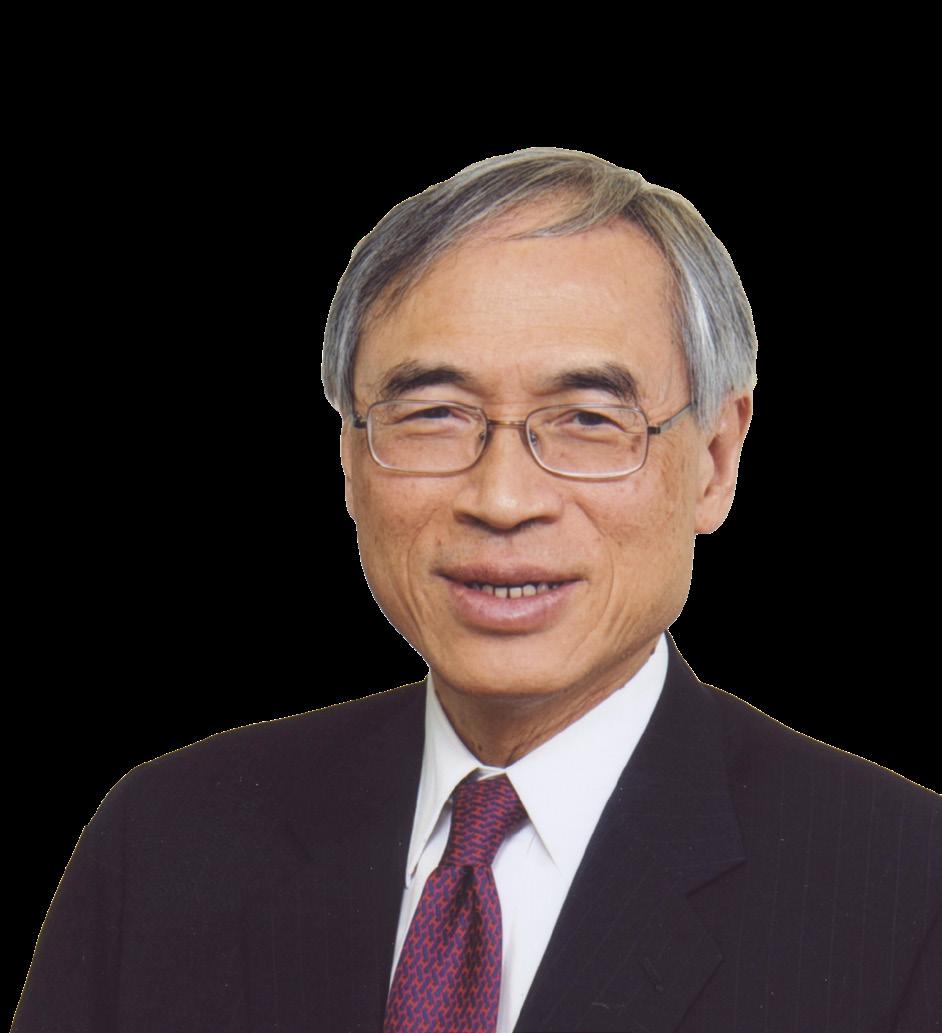
07 ASIA’S RISE TO GLOBAL DOMINANCE





ASIA UNLEASHED: THE POWER PLAY BEGINS
For China to define the Asian century, domination over Asia is essential.
This article is based on the round table curated by Ambassador Ranjan Mathai, Former Foreign Secretary of India, on Asia 2035 at the 9th Synergia Conclave 2023.
Historically, there is little evidence of Asians having a geopolitical concept of Asia, such as Europe and America, for their continental regions. East Asia, Southeast Asia, South Asia, Central Asia, and West Asia were different geopolitical theatres, sometimes overlapping. Sometimes, there were conquests between one and the other, but there was never one single overarching connection. Henry Kissinger, in his book on World Order, even claims that until the arrival of modern Western powers, no Asian language had a word for Asia.
The popular use of the term Asian Century is recent and speaks of China vs Asia even though many other parts of Asia have risen rapidly in the World Economic Order for decades - Japan, Korea, and Southeast Asia.
CONSTITUENTS OF GREAT POWER
In the 1970s, the Shah of Iran envisaged his country emerging as the fifth economic power in the world in the next two decades. We know what happened to that. World-beating economic growth is not enough to become the driver of a century. This comes with the potential to alter power distribution worldwide, as we saw in Europe in the 19th or the U.S. in the 20th century. It involves comprehensive national power, military technology industry, global diplomatic leadership, global trading and preponderance in soft power, and a leading
Historically, China never had domination except for East and parts of Southeast Asia. Apart from that, Japan, Korea, India, Iran, as well as Vietnam, Philippines, Indonesia, etc., will not go along with a Chinese-dominated order. The U.S. is also not standing still and is determined to retain global preponderance in Asia.
role in the institutional structures of world order and rule-making. All of this rests on one key foundation: the economy. The phenomenal growth of China from the 1990s and joined on a lesser scale from India in the 2000s made the expression Asian Century a projection that entered the popular lexicon by around 2010.
China’s role in reviving world growth after the 2008 financial crisis in the West, its technological and military strength, and the thrust of its Belt and Road Initiative have now made the talk of an Asian century essentially one of a Chinese century with other actors playing lesser roles.
THE CAVEATS
We in India have different ideas. There are too many unknowns, including some known unknowns, some which will come along, and some unknown unknowns. The biggest known unknown is the direction of internal politics within some of the major actors because of the extent of polarisation among all the Asian countries, the United States, and Europe.
SYNERGIA CONCLAVE 2023
To identify the key actors in Asia, the ADB did a 2011 study realizing the Asian century 2050, and they listed seven- China, Japan, Korea, RoK, India, Indonesia, Malaysia, and Thailand. Iran, Saudi Arabia, and Turkey could also be added to this list. Now, Vietnam and the Philippines, or maybe ASEAN as a whole. Russia, Australia, and the US will be key actors in the Asian trajectory. Russia, Australia, and France, for that matter, are physically present in Asia, and the U.S. is getting entrenched in the island chains of the Asia-Pacific.
Asia continues to be one of the world’s fastest-growing regions, and the IMF describes the region as a key driver, generating over 66 per cent of global growth at around 4.6 per cent per annum. The post-pandemic recovery has been generally impressive, though some questions have recently arisen about statistical data on growth rates, particularly the growth rates from China.
CHINA
Since about 2015, through the pandemic and after, it appeared that China’s rise to glob al supremacy was just a matter of time. Since 2022, Chinese growth has slowed. It now seems stuck in a property-related slump. The high U.S. interest rates are weakening its currency, but at the same time, the trade and tariff problems it is encountering have not increased, but they have slashed its usual trade surpluses. The People’s Bank of China has tools to stop the currency slide, but raising interest rates to match the Fed would exacerbate problems in the housing sector as well as its debt repayment.
Has the Belt and Road Initiative achieved by 2023 what it set out to do? That is the transformation of both land-based and sea-based routes. It seemed to be geoeconomically and geopolitically transformative at one stage. China is emerging as the world’s largest creditor for development. Still, recent trends suggest that BRI debt management is done with rollovers rather than repayment as creditors fail to profit from the investments.
China runs surpluses selling consumer, manufactured and infrastructure goods and buying largely commodities and other items that feed back into its own export machine. This leads developing countries to be largely tied to other markets.
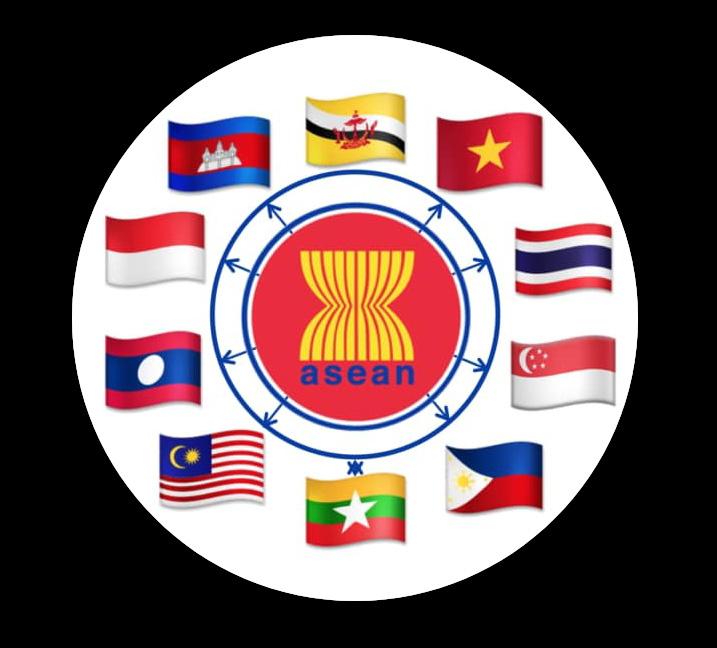
Take Sri Lanka for an example, it was being stated how China has overtaken India as the largest exporter to Sri Lanka. But where does Sri Lanka sell? It sells to the E.U., India, and the U.S; China ranks way down. So, when these countries want to make friends to sell, they must return to the West. The most recent US-China Leaders’ Summit suggests that the 2024 elections in the U.S. could be a major factor in determining China’s trajectory till 2035.
There is increasing consensus in the U.S. on treating China as a strategic competitor, but there are differences over the extent to which trade and financial decoupling should proceed. BRI was the first attempt to dominate what the geopoliticians call the world island, Eurasia, as a whole. And that is not going to happen without serious competition.
OTHER MAJOR ASIAN PLAYERS
Exports, infrastructure investment, local government expenditure and state-owned enterprises have powered China’s phenomenal growth till now. All four are facing serious headwinds, and household consumption, which could have compensated remains stuck below 40 per cent of GDP as against 50 to 60 in most other Asian major actors. Despite attempts at stimulus, household debt remains a serious problem.
One known unknown is whether China’s surge in advanced technology despite the U.S. efforts to stall it and green technology will spur a wave of new growth. It is uncertain at this point. The U.K.’s hosting of the first really big conference on artificial intelligence suggests that while there is a lot of technology in China, the West is still trying to lead the rule-making process.
Some recent data suggest that the Yuan is enlarging its role in global trade payments and international finance. It is presently the most active for global payments, but it is only 3.7 per cent of the total in the world, according to SWIFT data. It is only the fifth largest among the currency reserves held globally. Will this continue to grow till 2035, given that the current dilemmas of the Chinese policymakers have already led to capital controls and capital flight? Chinese citizens can take only $50,000 abroad. It’s a known unknown.
Japan is growing slowly, but it has grown nevertheless, and it remains a global trading power. It is now investing in initiatives rivalling the Belt and Road Initiative. It still holds huge external reserves. It’s at the cutting edge of many new transformative technologies. Now, it is developing massive deterrent missile forces, though they remain demographically negative. India’s growth is expected to remain steady at around 6 to 7 per cent, so it should overtake Germany and Japan to emerge as the third-largest economy well before 2035. India has demonstrated the potential to play a greater role in international finance bailing out Sri Lanka is a great example. However, its flip-flops in trade policy are not helping it expand its influence.The rupee is still not a player abroad. And energy remains like a ball and chain hobbling its growth. Yet, it has demonstrated a strategic economy. Another known unknown is whether the 2024 elections in India will impact its trajectory.
POLITICO-MILITARY
The status of Asia in 2023 is believed to be encouraging as Europe and the Levant are bogged down in Asia’s actual war, while the rest of Asia is not. However, military expenditures remain very high, including in ASEAN.
09 ASIA UNLEASHED: THE POWER PLAY BEGINS

There are tensions in the Taiwan Straits, South China Sea, and Northeast Asia. The standoff between India and China in Ladakh continues. And in all these situations, the central actor is China. Then there is Pakistan, domestically turbulent but still sponsoring terrorism. Their border with Afghanistan is also volatile, and there are too many unknown unknowns in the trajectory of India’s Western borders.
The possibility of Iran getting into a conflict with Israel persists. The trajectory of Iran-U.S.-Israel relations is the biggest unknown because of oil. Oil and gas will in 2035 still be the dominant energy sources for Asia, and a crisis in the Gulf could derail energy management and trade balances across Asia, just as the 1973 oil shock slowed down Europe. Today, four top oil importers are Asian- China, India, Japan, and South Korea. All five top LNG importers till last year were Asian - Japan, China, India, South Korea and Taiwan. The U.S. is sitting pretty in this situation as the world’s largest oil and gas producer.
Amongst the forecast of drivers and factors, one is political change. Will China’s political direction remain as it is? One simple signal. The sentiments expressed over the death of Li Keqiang, the former premier, had shades of mourning when Prime Minister Zhou Enlai died. It reflected public grief for an era of greater growth and possibility.
Does it mean something? Can growth in Asia continue on the same path, given that the financial situation in the world is changing? Military-industrial complexes are growing rapidly in all the key countries and will be one factor. However, not one Asian country has successfully designed a jet engine, whether commercial or military.
SOME SCENARIOS
2035 will not mark the milestone of the Asian cen-
tury. For China to define the Asian century, domination over Asia is essential. Historically, China has never had domination except for East and parts of Southeast Asia.
Apart from that, Japan, Korea, India, Iran, as well as Vietnam, Philippines, Indonesia, etc., will not go along with a Chinese-dominated order. The U.S. is also not standing still and is determined to retain global preponderance in Asia.
The best-case scenario is that the Chinese trajectory gets redefined either through internal change or by coexisting with the U.S. for a free and open Indo-Pacific, the Quad and a cold peace.
The most likely scenario is that China will not change course but will reach some temporary modus vivendi with the U.S. Japan, Korea and Australia remain closely tied to the U.S. ASEAN’s hedging strategy continues.
The growth of India, Indonesia, and Vietnam proceeds in a way that makes Chinese dominance less likely, though China will have the largest weight in Asia. We have several Black Swans - Taiwan, another war in the Gulf, the PLA deciding to push India around, North Korea out of control, another pandemic, etc.
RECOMMENDATIONS FOR INDIA
• Economy, economy, economy! Domestic first and regional integrations.
• Get other Asians to push for United Nations Security Council reform, provided the UNSC remains relevant.
• India needs to build Asian dialogues, leading to institutional structures like Europe, which was able to build with the Organization of Security and Cooperation in Europe once detente started.
10 ASIA UNLEASHED: THE POWER PLAY BEGINS

ASIA 2035: DRIVER OF A BETTER WORLD
“We need to continue to strengthen economic globalisation.”
The world is undergoing tremendous challenges and is much more dangerous than it used to be. We have experienced prosperity and peace for the past seventy-seven years since the Second World War. The Bretton Woods system built a world that has kept us going, but that system seems unable to function effectively now. Then there are multiple crises- in the Europe continent, the war in Ukraine and the Palestine/ Israel conflict.
The trend towards internationalisation and globalisation will continue because globalisation is the product that has kept us going for the last 77 years without having a third world war. Trade has gone up several hundred times since the Second World War. And we are all better off than we used to be. China is a good example; it has lifted 800 million people out of poverty. And India, too, has benefited.
There is a big Global South in which China and India can work together to strengthen globalisation. The Global South represents 80 per cent of the global population. The unipolar world is going, and we see the emergence of a multipolar world. The doubling of member countries in BRICS (from five to 11) is a sign, and China, India, and other members of BRICS are playing a leading role in this enterprise. The BRICS is an economic organisation that drives economic development and neo-development banks, Asian infrastructure banks etc.; India is the largest recipient of investment from these banks. Hopefully, the member countries of the enlarged BRICS can work together well.
China’s BRI is openly exclusive, welcoming other economic frame workers to collaborate - for example, with B3W (Build Back Better World, an international infrastructure investment initiative announced by the G-7 in June 2021 to counter BRI), EU Global Gateway, and India’s IMEC. All those infrastructures that are common consensus now should work together.
The next big trend is that along with BRICS, the Global South will create a new infrastructure revolution that will shape the world for better connectivity and understanding and prevent future conflicts. Climate is the next biggest challenge for the whole of mankind. We should first de-risk ourselves from climate threats. China, India, the U.S. and the EU must all work together to fight climate change. As big countries, we all have
a moral responsibility to prevent our Earth, our global village, from falling apart and being threatened by this climate change danger.
Digital and AI create new challenges. We have AI, data flows, etc. technologies, but they need a governance model. The world must collaborate to create the next generation of global governance in different spheres. AI is a double-edged sword, and we have to harness its good side and make it work for the benefit of mankind.
On its part, China is ready to make its contribution. It has been a full dialogue partner of the ASEAN since 1996; it wants to join the Comprehensive and Progressive Agreement for Trans-Pacific Partnership (CPTPP), a higher standard of free trade agreement. China also has economic summits with Africa, Latin America, Central Asia, the Arabs and ASEAN. China looks forward to an India-China economic cooperation as there are many complementary and supplementary roads here, and both countries can contribute. Economic globalisation is the best way to go forward-trade, investment, connectivity- and to prevent future conflict. Work on transparency, people-to-people exchanges, investment and infrastructure can bring a better world together.
RECOMMENDATIONS
• India and China should work together to strengthen the multilateral system; the old unipolar world is no longer functional. We need a multipolar world, but there’s not yet a multipolar system to support that. China, the EU, the U.S., India, and the Global South must work together. G20, BRICS and other platforms can strengthen communication and dialogue.
• There should be more people-to-people exchanges. China had 150 million people touring around the world before the pandemic. China is still sending a lot of tourists and student exchanges. China welcomes international students; before the pandemic, 20000 Indian students were studying in China, and we need more of them! India and China share a cultural heritage at their roots, which needs to be strengthened.
• Economic globalisation must be strengthened. Thanks to the Bretton Woods system, trade has prevented a global conflict for the last 78 years. Let us continue to do that.
DR HUIYAO WANG
President, Center for China and Globalization

SYNERGIA CONCLAVE 2023



2035: PEERING INTO INDIA’S ECONOMIC FUTURE
Given the tumultuous geopolitical landscape, what does 2035 hold for the Indian economy?

Suchitra
Padmanabhan
is the Policy Research Associate at Synergia Foundation and has Post Graduate Degree in Social Policy & Planning from the London School of Economics.
India ranks among the fastest-growing economies globally and is positioned to sustain this trajectory, aspiring to attain high-middle-income status by 2047, marking the centenary of Indian independence. The nation is resolutely committed to navigating the challenges of climate change, aligning with its ambitious target of achieving net-zero emissions by 2070.
Despite these advancements, certain challenges persist. Consumption inequality endures, reflected in a Gini index hovering around 35 for the past two decades. Child malnutrition remains a concern, with 35.5 per cent of children under five years experiencing stunting, a figure that rises to 67 per cent among children aged 6-59 months. While headline employment indicators have improved since 2020, apprehensions linger regarding the quality of jobs generated, the actual wage growth, and the relatively low participation of women in the labour force.
INDIA’S GROWTH TRAJECTORY
India’s aspiration to achieve high-income status by 2047 will need to be realized through a climate-resilient growth process that delivers broad-based gains to the bottom half of the population. Growth-oriented reforms must be accompanied by an expansion in good
India is poised to surpass Japan and secure its position as the second-largest economy in Asia by 2030. The Indian economy, having experienced two consecutive years of rapid growth in 2021 and 2022, has sustained robust expansion throughout 2023.
jobs that keeps pace with the number of labour market entrants. At the same time, gaps in economic participation will need to be addressed, including by bringing more women into the workforce.
After real GDP contracted in FY20/21 due to the COVID-19 pandemic, growth bounced back strongly in FY21/22, supported by accommodative monetary and fiscal policies and wide vaccine coverage. Consequently, in 2022, India emerged as one of the world’s fastest–growing economies despite significant global environmental challenges–including renewed supply line disruptions following the rise in geopolitical tensions, the synchronized tightening of global monetary policies, and inflationary pressures.
In FY22/23, India’s real GDP expanded by an estimated 6.9 per cent. Growth was underpinned by robust domestic demand, strong investment activity bolstered by the government’s push for investment in infrastructure, and buoyant private consumption, particularly among higher-income earners. The composition of domestic demand also changed, with government con-
ECONOMICS
sumption being lower due to fiscal consolidation. Since Q3 FY22/23, however, there have been signs of moderation, although the overall growth momentum remains robust. The persisting headwinds – rising borrowing costs, tightening financial conditions and ongoing inflationary pressures – are expected to weigh on India’s growth in FY23/24. Real GDP growth will likely moderate to 6.3 per cent in FY23/24 from the estimated 6.9 per cent in FY22/23.
The general government fiscal deficit and public debt to GDP ratio increased sharply in FY20/21 and have been declining gradually since then, with the fiscal deficit falling from over 13 per cent in FY20/21 to an estimated 9.4 per cent in FY22/23. Public debt has fallen from over 87 per cent of GDP to around 83 per cent over the same period. Increased revenues and a gradual withdrawal of pandemic-related stimulus measures have largely driven the consolidation. At the same time, the government has remained committed to increasing capital spending, particularly on infrastructure, to boost growth and competitiveness.
POSITIVE SIGNALS
According to the latest India Development Update (IDU) from the World Bank, India persists in demonstrating resilience amidst a challenging global environment. Despite considerable global hurdles, the report, which serves as the Bank’s flagship semiannual overview of the Indian economy, notes that India achieved a growth rate of 7.2% in FY22/23, making it one of the fastest-growing major economies. India’s growth rate was the second-highest among G20 nations, nearly double the average for emerging market economies. This resilience was driven by robust domestic demand, substantial public infrastructure investment, and a strengthening financial sector. Bank credit growth also increased to 15.8% in the first quarter of FY23/24, compared to 13.3% in the same period of FY22/23.
However, the IDU anticipates that global challenges will persist and intensify due to high global interest
rates, geopolitical tensions, and sluggish global demand. Consequently, global economic growth is expected to decelerate over the medium term, influenced by these combined factors.
Given these circumstances, the World Bank projects India’s GDP growth for FY23/24 to be 6.3%. This expected moderation is primarily attributed to challenging external conditions and diminishing pent-up demand. Nevertheless, the service sector is anticipated to maintain strong activity with a growth rate of 7.4%, and investment growth is projected to remain robust at 8.9%.
Auguste Tano Kouame, the World Bank’s Country Director in India, commented on the short-term challenges posed by an adverse global environment, emphasizing the need for tapping into public spending to attract more private investments, thereby creating more favourable conditions for India to seize global opportunities and achieve higher growth in the future.
Recent months saw a spike in inflation, reaching 7.8% in July, driven by increased prices of food items like wheat and rice due to adverse weather conditions. The World Bank expects inflation to gradually decrease as food prices normalize and government measures enhance the supply of key commodities.
Dhruv Sharma, Senior Economist at the World Bank and lead author of the report projects a moderation in inflation, asserting that overall conditions will remain conducive for private investment. He also anticipates the growth of foreign direct investment in India as the global value chain rebalances.
Looking at fiscal indicators, the World Bank foresees fiscal consolidation continuing in FY23/24, with the central government fiscal deficit is projected to decline from 6.4% to 5.9% of GDP. Public debt is expected to stabilize at 83% of GDP. On the external front, the current account deficit is anticipated to narrow to 1.4% of GDP, with sufficient financing from foreign investment flows and support from large foreign reserves.

13 2035: PEERING INTO INDIA’S ECONOMIC FUTURE

OUTLOOK
According to a report unveiled by S&P Global, the nation’s GDP is anticipated to expand from 6.4% in 2023 to 7% in 2026. The report foresees India ascending to the third-largest economy by 2030. Presently, India ranks as the fifth-largest economy globally, trailing behind the U.S. China, Germany, and Japan.
“We see India reaching 7 per cent in 2026-27 fiscal... India is set to become the third-largest economy by 2030, and we expect it will be the fastest-growing major economy in the next three years,” S&P said.
As per the “Global Credit Outlook 2024” published by S&P, India is expected to lead as the fastest-growing emerging market worldwide.
However, determining whether the country can successfully transform into the next major global manufacturing hub is a crucial challenge.
The report further underscores that India’s growth is projected to be 6.4% in the fiscal year 2023-24, marking a decrease from the 7.2% recorded in the preceding financial year. The rating agency anticipates that the growth rate will persist at 6.4% in 2024-25 before witnessing an upturn to 6.9% in the subsequent year, eventually reaching 7% in 2026-27.
DETERMINANTS OF CHANGE
“A strong logistics framework will be key in transforming India from a services-dominated economy into a manufacturing-dominant one,” according to the report.
The rating agency emphasises the importance of India’s ascent as a global manufacturing hub, highlighting a significant opportunity for the country. It underscores the need for a robust logistics framework to transition India’s economic focus from service-oriented to manufacturing-dominated.
To unlock the potential of the labour market, S&P recommends enhancing the skills of workers and increasing female participation in the workforce. The agency believes that success in these areas will enable India to harness its demographic dividend.
“Success in these two areas will enable India to realise its demographic dividend,” it said.
S&P emphasizes that the flourishing domestic digital market in India has the potential to drive the growth of the high-potential startup ecosystem, particularly in financial and consumer technology, in the upcoming decade.
James Sullivan, the Managing Director of Asia Pacific Equity Research at JPMorgan, anticipates that the Indian economy will double to $7 trillion by 2030, with the manufacturing sector’s contribution increasing to nearly 25% from the current 17%. Additionally, he foresees exports doubling to over a trillion dollars. Sullivan envisions India ascending to the position of the world’s third-largest economy by 2027 as part of this growth trajectory.
According to the S&P Global report, India is poised to surpass Japan and secure its position as the second-largest economy in Asia by 2030. The Indian economy, having experienced two consecutive years of rapid growth in 2021 and 2022, has sustained robust expansion throughout 2023.
Currently holding the rank of the world’s fifth-largest economy, India is projected to surpass Japan and claim the position of the third-largest global economy, boasting an anticipated GDP of $7.3 trillion by 2030, according to the latest report from S&P Global Market Intelligence.
POSITIVE NEAR-TERM HORIZON
S&P Global underscores an optimistic near-term economic outlook, projecting sustained rapid expan-
14 2035: PEERING INTO INDIA’S ECONOMIC FUTURE
sion throughout 2023 and 2024, primarily driven by robust domestic demand. The report also points to a decade-long influx of foreign direct investments (FDI) into India, reflecting the nation’s favourable long-term growth prospects, supported by a youthful demographic profile and increasing urban household incomes.
According to the report, India’s nominal GDP, measured in USD terms, is anticipated to surge from $3.5 trillion in 2022 to $7.3 trillion by 2030. This substantial growth trajectory is expected to position India as the second-largest economy in the Asia-Pacific region, surpassing Japan. By 2030, it is projected to exceed that of Germany.
The United States currently maintains its position as the world’s largest economy, boasting a GDP of $25.5 trillion, representing a quarter of the global GDP. China follows as the second-largest economy, with a GDP of approximately $18 trillion, constituting nearly 17.9 per cent of the world GDP. Japan ranks as the third-largest economy with a GDP of $4.2 trillion, and Germany holds the fourth position with a GDP of $4 trillion.
LONG-TERM GROWTH DRIVERS
S&P Global outlines several key factors supporting India’s enduring economic prospects. These factors encompass a swiftly expanding middle class, driving consumer spending, a thriving domestic consumer market, and substantial investments from multinational corporations across diverse sectors such as manufacturing, infrastructure, and services.
Moreover, India’s ongoing digital transformation is poised to accelerate the growth of e-commerce, reshaping the retail consumer market in the next decade. The
EXPERT COMMENT
INDIA’S MEGA FUTURE!
India has progressed, profited and has a mega future interest in global leadership. I can hardly imagine any country, except perhaps the EU - if it does its work well - that can have such an impact, thinking 50 years ahead.
China is looking into itself, India is global, the U.S. is troubled, and Europe is slow, but in my view, it is building itself. What 1.5 billion Indians can do in the long term is something that is more powerful than any other geopolitical force seen from a long-term perspective.
Corruption is what undermines logical thinking of
report highlights that this transformation has attracted investments from global technology and e-commerce giants into the Indian market. The projection indicates that by 2030, the number of internet users in India will reach 1.1 billion, doubling from the estimated 500 million in 2020.
The report underlines the resilience of India’s Foreign Direct Investment (FDI) inflows, which have shown consistent momentum over the past five years, even amid the pandemic years of 2020-2022. Notably, investments from global technology multinationals (MNCs) and a notable increase in FDI from manufacturing firms contribute significantly to this ongoing growth.
Assessment
India is expected to persist as one of the globe’s swiftest-growing economies in the coming decade, establishing itself as a vital long-term growth market for multinational companies spanning diverse industries. This encompasses manufacturing, services, and sectors such as banking, insurance, asset management, healthcare, and information technology.
As 2035 appears on the economic horizon, India has a number of prosperity-supporting trends, including its digital transformation, technological moorings, a rapidly growing middle class, propelling consumer spending, a flourishing domestic consumer market, and significant investments from multinational corporations.
what the political economy needs to face. In my view and experience, I look to India to be a vocal leader on these issues. India, surely, will be a leader in the technological realm. I know that in comparison with other regions, India is but a short step from leadership.
We stand a chance if we have the courage to put wellbeing at the core of our understanding of prosper ity rather than the usual economic measure ments?
PROF MATS KARLSSON
Former
VP of World Bank

15 2035: PEERING INTO INDIA’S ECONOMIC FUTURE

SYNERGIA ASSESSMENT

ASIA 2035
The idea of the ‘Asian Century’ argues that the 21st-century international order will be defined by Asia’s pre-eminence, the way the U.S. pre-eminence defined the international order in the 20th Century and Europe in the 19th Century.
Asia’s economic revolution —stimulated by many countries on the continent—over the past 60 years is unprecedented.
However, given the transformational events that have occurred in the recent past, does the concept of an Asian Century still hold? Is economic heft sufficient for Asia to claim the Century?
More importantly, what are the Key Drivers or factors that will impact the trajectory of Asia over the next ten years, and what are the plausible scenarios that could emerge in Asia by 2035?
Also, looking at the future of Asia in isolation without examining the continent’s economic opportunities, challenges and projected growth would render any discussion on the subject incomplete.
No doubt, the realisation of the Asian Century will be a long-drawn process that will require cooperation between China and India. It will only be by the 2070s that Asia
KEY DRIVERS
When it comes to identifying the Key Drivers of change that will impact the next 10 to 15 years at a Global and Asian level, the following major aspects come to the fore:
• Peace/ absence of conflicts.
• U.S. China Strategic Competition.
• Globalisation in the face of onshoring.
• Power diffusion and the rise of the Global South lead by Asia.
• Relevance of alliances.
• Climate change will be a common risk across the board
• Global digital interconnectivity cannot be ignored.
Recommendations.
The world should take a cue from ASEAN and extrapolate its functioning in a wider context to ensure peace or an absence of conflict.

Climate change and the regulation of AI are two areas that need global cooperation on priority.
The international order must be in sync with the evolving global balance of power.
MAJOR GENERAL PAUL NAIDU (RETD)
Chief Strategic Officer, Synergia
16 SYNERGIA ASSESSMENT - ASIA 2035
-
SYNERGIA CONCLAVE 2023


INDO-PACIFIC CHALLENGES


Indo-Pacific is a natural region where the destinies of constituent nations are deeply interlinked.
This article is based on the address given by Admiral R Hari Kumar, Chief of the Naval Staff, Indian Navy, at the 9th Synergia Conclave 2023.
The most contemporary global issue is the centrality of the Indo-Pacific region and the Indo-Pacific strategy. There are eight countries and two international constructs that have already come out with their Indo-Pacific strategies.
GEOGRAPHICAL CHALLENGES
Geography is one constant in an ever-changing world of human interactions that cannot be significantly altered. Surprisingly, the term Indo-Pacific is essentially geographic, with the Indian Ocean and the Pacific Ocean fused into one homogeneous entity.
On the one hand, the Indian Ocean is geographically the smallest, geologically the youngest and geo-strategically the most complex, with an uninterrupted land capping to the north, maritime choke points to the east and the west, limiting access and the barren, ice-clad Antarctica to the south. It is recorded that it has been travelled at least 5000 years ago.
On the other hand, the Pacific is the largest ocean of them all. It is free to both the north and the south.It is empty at its core, but as one reaches to its rim to the west, fault lines become quite prominent. The Pacific Ocean is the next oldest travelled ocean after the Indian Ocean. It is recorded that it has been travelled as much as 2000 years ago.
Given the expanse of the Indian Ocean region, 20 times the landmass of Bharat, and that is only IOR, not the Indo-Pacific, no one can do it alone, and therefore, there is a need to collaborate with likeminded partners. Bharatiya Nav Sena collaborates and cooperates with likeminded navies to strengthen collective maritime competence.
This region has some of the world’s deepest oceanic trenches as well as the highest mountains. It is home to nearly two out of every three island nations in the world and seven of the ten largest continental nations. It has some of the world’s least populated or sparsely populated regions and the most densely populated ones; it is a region of contradictions.
However, one feature that unites them is the oceans. The dependence on the monsoons is the defining climatological attribute of the Indian Ocean. On the Pacific, El Nino on the South American coast perhaps sums up the interconnect between these waters. The monsoons bring rain to the core of the Indo-Pacific, South and Southeast Asia, watering the fields, feeding the populace, and driving growth and prosperity. Therefore, the region’s predominant characteristic is its maritime orientation.
The Indo-Pacific is a natural region where the destinies of constituent nations are deeply interlinked. History is testimony to the fact that cultural and civi-
SYNERGIA CONCLAVE 2023
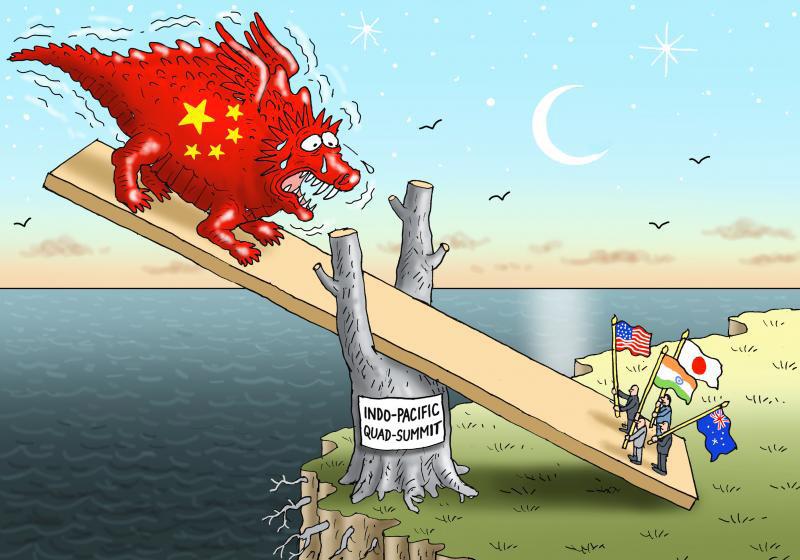
lizational connections in the region were capitalized by seafarers both from ancient times to the current time, and it continues to be so even now.
However, the geography of oceans also means that these bodies are largely uncontrolled, un-owned, ungoverned and unregulated. They are uncontrolled because nearly 70 per cent of the earth is oceans, 85 per cent of nation-states have access to the seas, yet its fluidity means that one cannot seize, hold, or occupy the vast waters. The seas essentially remain free.
These uncontrolled seas are also largely un-owned. Only about 5 per cent of the seas, being the territorial seas, are confined by the laws of the land, while the remaining 95 per cent are free for navigation and overflight. Therefore, in terms of owning the resource, nearly 90 per cent of the seas by volume and 64 per cent by surface area are beyond exclusive economic zones and, thereby, beyond any state’s jurisdiction.
This lack of legal ownership translates into the seas remaining largely unregulated. Their vastness, accompanied by the tyranny of distance, means that the seas cannot be organized or governed to any significant distance from the shores. These characteristics, in turn, contribute to the oceans being a global commons, free for all to access, navigate and use in pursuit of respective interests. So, being global commons, the oceans also provide unfettered reach and access to nation-states and, therefore, are a medium of choice for power projection. With the Indo-Pacific washing the shores of six of the world’s seven continents, this space is definitely of great strategic importance.
INTERNATIONAL RELATIONS CHALLENGES
The definition of Indo-Pacific as a strategic geography is also a mix of contradictions. For Bharat, just
like for Japan and Australia, it extends from the eastern shores of Africa to the western shores of the Americas. For the U.S. and Canada, it stretches from the Pacific coastline to the Indian Ocean.
China opposes the construct and prefers a more continental Asia-Pacific one. ASEAN puts itself at the centre of it, whatever may be interpreted by others. However, what is undisputed is that players, actors and forces, both regional and extra-regional, are vying for their share of the pie in the resource-rich Indo-Pacific.
The most critical of them is the region’s abundance of human resources. It has nearly 60 per cent of the world’s population, home to some 4.3 billion people, including the world’s most populous countries, Bharat and China. At the same time, the region also contains some of the smallest populations on the planet, especially among the small island developing states of the region.
This diversity results in equally divergent aspirations and interests of people and states, often leading to competition and contestation. Other resources like food, fuel, minerals, rare earth elements, etc., are also found in abundance in the region, once again adding to the jostling for consumables in the region.
In addition to the diversities, the region is also characterized by the coexistence of almost the entire gamut of political systems. From monarchy to republics, democracy to autocracy, capitalism to communism or socialism, by-party to multi-party systems, kings, presidents, prime ministers, and premiers all hold sway over the regions.
Such a heterogeneous mix results in differing worldviews and outlooks. Therefore, the US-China Great Power Competition is being played out in the region across geographies, spheres and sectors. As they vie for
18 INDO-PACIFIC CHALLENGES
influence, one witnesses hedging being adopted by several states to further their interests. This has given rise to a number of mini-laterals and multilaterals as well as infrastructure and financing initiatives in the region, often at the expense of the other.
Some states are attempting to alter the basic control of the global commons to seek greater domination and control.
SECURITY CHALLENGES
There is an increasing challenge to universally accepted rules, regulations and conventions, turning global commons into contested seas. China, for instance, is pushing the envelope – be it debt traps or unilateral actions, encroachments in the South China Sea or, altered geography or expansionist designs in the Indian Ocean with the acquisition of ports and bases.
What many see as a response: the AUKUS deal has added to the mix of an already nuclearized region as almost all nuclear weapon states are either located in the Indo-Pacific or have a military presence there.
The region is also home to 9 of the 10 largest standing armies and 7 of the 10 highest defence spenders with 105 active conflicts. It accounts for the highest number of conflicts globally. It also hosts some of the most volatile hotspots from West Asia to the Horn of Africa, the South China Sea and the East China Sea.
We are witnessing the ongoing Israel-Hamas conflict, spilling out into the Red Sea and thereby into the Indo-Pacific. Regarding the maritime domain, the region has the credible presence of many extra-regional forces.
The Indian Ocean, North Indian Ocean alone at any point in time has upwards of about 50 warships of extra-regional forces, which remain deployed for various missions, including anti-piracy patrols off the Gulf of Aden. This means there is greater interaction between them at sea, and if these are not managed well, there is a greater possibility of miscalculation and perhaps conflict.
The unconventional challenges of military aggression have and will continue to exist in the maritime domain. In addition, other challenges such as transit rights, piracy, armed robbery at sea, maritime terrorism, humanitarian crises necessitating evacuation operations, trafficking, smuggling, illegal, unreported and unregulated fishing, and proliferation of private armed security all make the maritime security metrics quite complicated.
In 2022, Bharat’s Information Fusion Centre monitored about 4,728 maritime incidents in the Indian Ocean region alone. Additionally, there is also the Grey Rhino of climate change. With the continuous rise in sea levels, many states in the region are likely to face existential crises.
In the words of Fiji’s defence minister, “Machine guns, fighter jets, grey ships and green battalions. They are not our primary strategic concern.
Waves are crashing at our doorsteps; winds are battering at our homes. We are being assaulted by this enemy from many angles.”
TRADE AND ECONOMIC CHALLENGES
Sixty-two per cent of the global GDP is in this region, with the USA, China, Japan, and Bharat being four of the top five economies resident here.
Seven of the top ten export destinations are in the Indo-Pacific, but half of the global trade transits through the maritime trade routes in the region, and nine out of the ten busiest ports in the world are in the Indo-Pacific.
For Bharat as well, about 90 per cent of trade by volume, more than 70 per cent by value, and nearly 90 per cent of our oil imports are transported by the seas. Four-fifths of Bharat’s oil, half of the natural gas and half of LPG are imported from the Indo-Pacific nations.
Such vast trade and economic enterprise is underpinned by the unmatched efficiency that maritime transport affords.
Therefore, maritime transportation will remain the most efficient means for a very long time unless some new means of transportation, maybe quantum transportation or something like that, is invented later.
Given the maritime orientation of the Indo-Pacific, navies and maritime security agencies will play an important role in providing an overarching security umbrella.
ROLE OF THE INDIAN NAVY
Through sustained presence, credible responses, cooperation, and collaboration with friends, Bharati Nav Sena adds value to the Indo-Pacific, both figuratively and literally.
Given the expanse of the Indian Ocean region, 20 times the landmass of Bharat, and that is only IOR, not the Indo-Pacific, no one can do it alone, and therefore, there is a need to collaborate with like-mind ed partners.
Bharatiya Nav Sena collaborates and cooper ates with like-minded navies to strengthen collective mar itime competence. Each Navy or nation in the Indo-Pa cific, big or small, brings certain unique capabili

19 INDO-PACIFIC CHALLENGES

ties to the table. Expertise, area knowledge, area understanding, nuances, intelligence, information, technology, geographical locations, assets, etc.
One prime example of the Indian Navy’s endeavours in this regard is its mission-based deployments. In the past two years, its ships clocked about 17,000 days at sea, with submarines deployed extensively for over 1,800 days and aircraft logged over 26,000 hours. At any given time, assets are deployed across India’s areas of interest to respond to contingencies that may arise.
India’s credibility has been further strengthened by the fact that it is fast becoming self-reliant to a large extent in its defence capabilities, especially with regard to shipbuilding.
The indigenous content on board Indian warships has consistently increased since the first indigenous capital warship, Nilgiri, was commissioned more than five decades ago.
It has now reached 75 per cent onboard India’s first indigenous aircraft carrier, Vikranth, the state-of-theart Vishakhapatnam class stealth destroyers, and the new Nilgiri, presently under construction, setting the stage for a transformative change.
Indian defence products may find applicability and use for our friends in the region. The Atma Nirbharta Initiative will further contribute to collaborative security in the Indo-Pacific region.
At the strategic level, the Indian Navy is actively pursuing endeavours under the ambit of government initiatives such as the Act East Policy, ASEAN, ADMM+, IORA, Indian Ocean Commission, IPOI, Djibouti Code of Conduct and so on. All these initiatives provide the necessary framework for meaningful and constructive dialogue and form the basis for the Navy’s engagement with like-minded maritime nations.
At the operational level, initiatives such as standing arrangements for faster operational turnaround of assets, that is, reciprocal logistic agreements for interoperability and operation of surface air assets submarines from each other’s bases access facilities, all this help improve interoperability, enhance security and reaffirm our commitment to be the first port of call for our friendly maritime nations in the Indo-Pacific.
In addition, forging collaborative frameworks such as the Indian Ocean Naval Symposium, the Goa Maritime Conclave, and the Milan exercise are important elements of our commitment to the region.
India has established the Information Fusion Centre as the IOR’s hub of maritime security information. Through white shipping agreements with 25 countries and one multinational construct, 15 countries have been invited to join the centre.
The Navy works towards enhancing the capability of friends in the region by providing assets, installing coastal radar chains, and training personnel from friendly foreign navies.
Holistic maritime security in the region cannot be achieved by Bharatiya Navsena alone. The overarching outlook is towards finding regional solutions to regional problems.
The approach towards addressing regional problems is expanding the ambit of engagements to the free flow of ideas, experiences, organizations, cultures and best practices. This will further harmonize our endeavours in the Indo-Pacific, adding more value to not only Bharati Navasena’s effort but also to other like-minded states.
20 INDO-PACIFIC CHALLENGES
Conclusion



SUSHI AND SPICES: DECODING THE INDO-JAPAN ALLIANCE
The India-Japan partnership extends beyond bilateral ties, finding expression in trilateral arrangements and the Quad framework.

Sambratha Shetty is the COO at Synergia Foundation and holds a Masters’ in Science from the University of Greenwich, UK.
The evolving dynamics of the Japan-India relationship have been shaped by a combination of historical ties, economic complementarity, and shared concerns over regional security, particularly in light of China’s growing influence. To better understand this important relationship, one must undertake a journey into its history, economic angle and strategic partnership with a focus on the Quad framework.
HISTORICAL CONTEXT
Japan and India share a long history of cultural exchange dating back to ancient times. Most striking is Buddhism, which originated in India and spread to Japan around the 6th century, fostering a deep cultural connection. The 8th-century work, “The Nihon Shoki,” mentions Japanese envoys visiting India, laying the foundation for diplomatic engagements. Large number of Japanese make a pilgrimage to Bodh Gaya in Bihar, where Gautama Buddha (Prince Siddhartha) attained enlightenment and became the Buddha.
During World War II, thousands of Indians serving with the British Indian Army fell into the hands of the Imperial Japanese Army in Singapore, Malaya and later in Burma. The narrative of their treatment at the hands of their capturers is a horrendous story. However, those who volunteered to join the rebel Indian National Army
The India-Japan partnership has become indispensable in navigating the complexities of the changing global order. With a shared commitment to democratic values, economic growth, and regional stability, both nations are likely to continue their positive trajectory. While challenges exist, such as economic and bureaucratic hurdles, the benefits of collaboration far outweigh the obstacles.
created by Japan fared much better. Post-World War II, Japan and India found themselves on a path of recovery and development. The 1952 Peace Treaty marked a turning point, ending hostilities and establishing diplomatic relations between the two nations. However, during the Cold War, geopolitical alignments and economic vision differences kept the two nations at a guarded distance.
The post-Cold War era saw a significant shift, driven by economic complementarity and shared concerns over China’s regional influence. India’s “Look East Policy”, initiated by Prime Minister P. V. Narasimha Rao in 1993 marked a turning point, opening avenues for increased engagement with successful Asian economies.
The relationship weathered a brief setback in 1998 following India’s nuclear tests, but by 2018, under the leadership of Prime Ministers Modi and Abe, it was elevated to a “special strategic and global partnership.”

ECONOMIC COLLABORATION
Economic ties between Japan and India have flourished, with Japan playing a pivotal role in India’s infrastructure development. The Comprehensive Economic Partnership Agreement (CEPA), signed in 2011, further facilitated trade and economic cooperation.
Notable projects, such as the Delhi Metro and Mumbai-Ahmedabad High-Speed Rail, highlight Japan’s contributions. In 2021, Japan International Cooperation Agency (JICA) signed an agreement with the Government of India to provide Japanese (ODA) loan amounting to Japanese Yen 52,036 million (approximately Rs 3,717 Crore) for the development of Phase 2 of ‘R6 (Nagawara- Gottigere, approx. 22.0 km), 2A (Silk Board K R Puram, approx.20.0 km) and 2B ((K R Puram Kempegowda International Airport Terminal, approx.38. 0 km).
The systemic shift in Japan’s national security posture away from pacifism and India’s rising Indo-Pacific profile created opportunities for deeper collaboration. Economic cooperation now focuses on capacity building, with Foreign Direct Investment (FDI) and Japan’s Overseas Development Assistance (ODA) program supporting infrastructure development in India’s Northeast region.
STRATEGIC PARTNERSHIP:
The strategic dimension of the Japan-India relationship has gained prominence, driven by shared apprehensions over China’s activities in the region. The Galwan clashes in July 2020 marked a turning point, prompting India to strengthen ties with friendly powers like Japan to bolster its strategic deterrence against Beijing. Joint military exercises, training programs, and defence equipment and technology transfers underscore the rapid progress in security cooperation.
Japan’s support for India’s entry into prestigious international forums, such as the Nuclear Suppliers Group, and policy coordination in regional and Indo-Pacific institutions contribute to the non-material aspects of India’s global status. The recent announcement by
the Kishida government to expand its ODA program with a focus on enhancing “security and deterrence capabilities” aligns with India’s strategic objectives.
TRILATERALS AND THE QUAD
The India-Japan partnership extends beyond bilateral ties, finding expression in trilateral arrangements and the Quad framework. The India-Japan-US and India-Japan-Australia trilateral dialogues, initiated in 2011 and 2015, respectively, serve as stepping stones to the Quad. These arrangements allow for better coordination and alignment on regional issues, offering a platform for like-minded nations to work together.
The Quad, consisting of India, Japan, the United States, and Australia, has emerged as a key player in the Indo-Pacific region. All four members share a common goal of managing an assertive China and upholding the “rules-based order.” While not an Asian NATO, the Quad provides a loose-knit network for defence cooperation, intelligence-sharing, and logistics support. Ideational elements, such as promoting the Free and Open Indo-Pacific (FOIP) strategy, underline the non-military aspects of the Quad.
LOOKING AHEAD
The India-Japan partnership has become indispensable in navigating the complexities of the changing global order. With a shared commitment to democratic values, economic growth, and regional stability, both nations are likely to continue their positive trajectory. While challenges exist, such as economic and bureaucratic hurdles, the benefits of collaboration far outweigh the obstacles.
As the Quad strengthens its position in the Indo-Pacific, the India-Japan partnership plays a pivotal role in advancing regional security and stability. The ongoing collaboration in various sectors, coupled with diplomatic initiatives, cultural exchanges, and trilateral engagements, positions the relationship for continued growth. The future of the Japan-India partnership looks promising, grounded in a shared vision for a free, open, and prosperous Indo-Pacific region.
22 SUSHI AND SPICES: DECODING THE INDO-JAPAN ALLIANCE

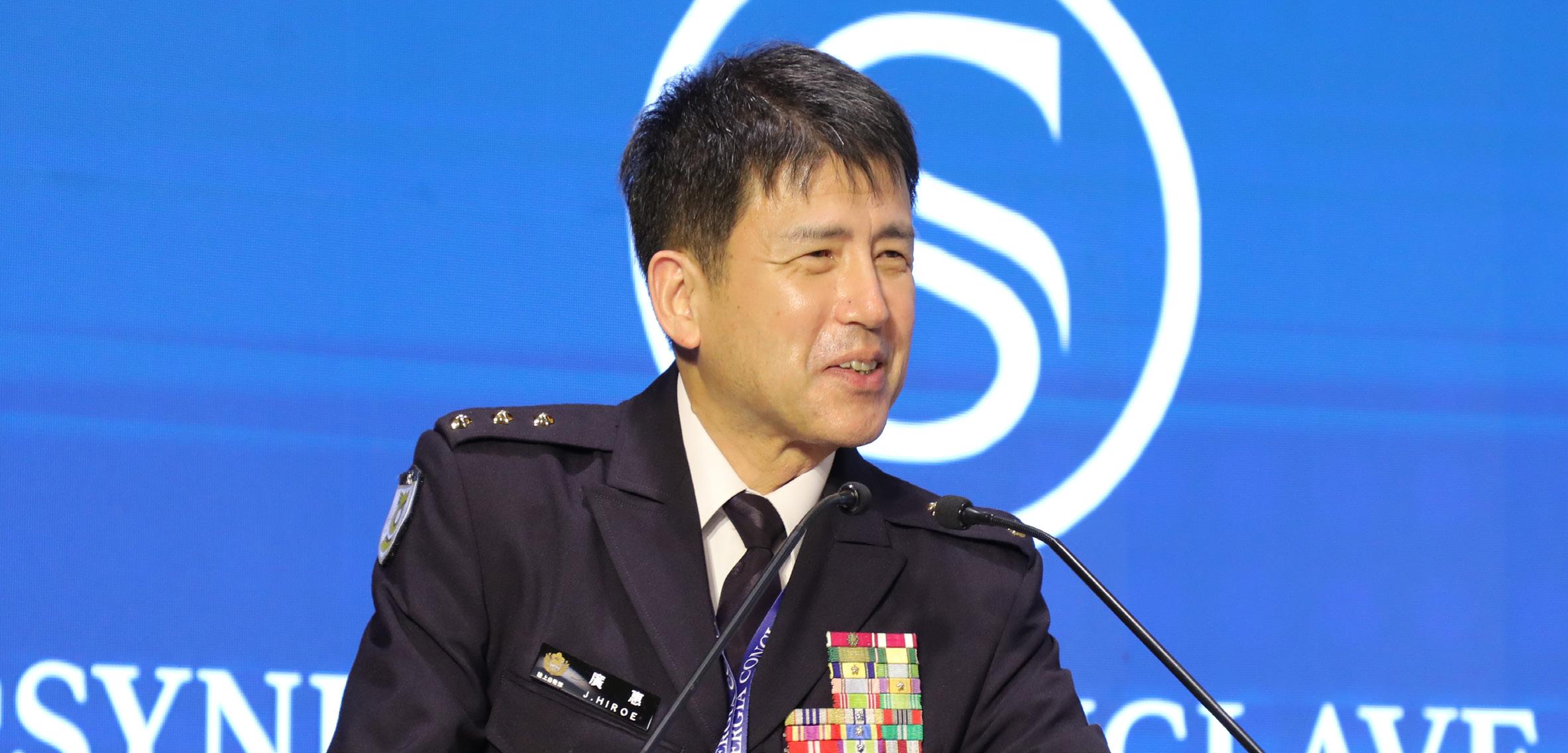
NEW LAND OPERATIONS
Future conflicts will probably be more complex, more lethal and more contested.
This article is based on the round table curated by Lieutenant General Hiroe Jiro, Commanding General, TERCOM - Japan, on New Domains and Land Operations at 9th Synergia Conclave 2023.
In all future wars, electromagnetic spectrum, cyber, and space superiority will be the keys to the next battlefield. Almost every army in the world is trying to realise the multi-domain operation, which in Japan is called the cross-domain operation. In France, it is called a multi-military operation. The U.S. Army has five domains: land, air, maritime, cyberspace and space. In addition to the five domains, Japan recognises the electromagnetic spectrum as a separate domain. In all future wars, electromagnetic spectrum, cyber, and space superiority will be the keys to the next battlefield.
CROSS-DOMAIN WARFARE IN UKRAINE
In July 2014, in an operation conducted in Ukraine, all indigenous radios of the Ukrainian army were jammed by Russian EW equipment. The Ukrainian forces used their private phone, and the microwaves emitted from those phones were traced by the Russian EW equipment called the Rorandzit. Surprisingly, this equipment can identify the individuals of the Ukrainian forces. Furthermore, this information will be useful in finding out about their families, fathers and mothers. So, the Russian EW units started sending messages directly to the families’ cell phones. For example, your son died. The concerned families tried to call their sons, which increased cell phone traffic and revealed the location of Ukrainian forces. Two Ukrainian platoons were destroyed in this operation. The Ukrainian forces also used satellite communication, but the Russian UAV, called R-110, also detected this communication


The U.S. Army has five domains: land, air, maritime, cyberspace and space.
and that data was transferred to the EWPQ called Rail 3. Then Rail 3 found the location of the Ukrainian forces, and the Russian forces used field artillery to attack the Ukrainian forces. This is an excellent example of the combination of three domains-space, land and EW. The Russians also mixed psychological warfare with their EW attacks, sending SMS messages to Ukrainian soldiers that they were surrounded and must, therefore, escape from the area, sowing a loss of morale.
FUTURE OPERATIONAL CONCEPTS
Based on those examples, future operations can be divided into two categories: non-kinetic operations and kinetic operations. For non-kinetic operations, the target can be the adversary command post or the platoons in the cyber domain. Laser beams or conventional firepower can be grouped with other domain weapons for the kinetic domains. For example, while attacking a naval platform, EW jammers can reduce its radar coverage thus allowing missiles to slip through its defences to strike it. This would be a combination of the EW domain, sea domain, land domain, etc.
For conducting artillery operations, the location data of the adversary forces is needed. Usually, you can take those data using binoculars, satellite images, or even EW equipment. However, there is yet to be a capability worldwide to take the location data through cyber operations. We heavily depend on civilian technology in the cyber domain, making it necessary to cooperate with the civilian industries. Furthermore, the cyber domain can connect all over the world. That means we need to enhance cooperation, not only with the civilian industry but also worldwide.
SYNERGIA CONCLAVE 2023

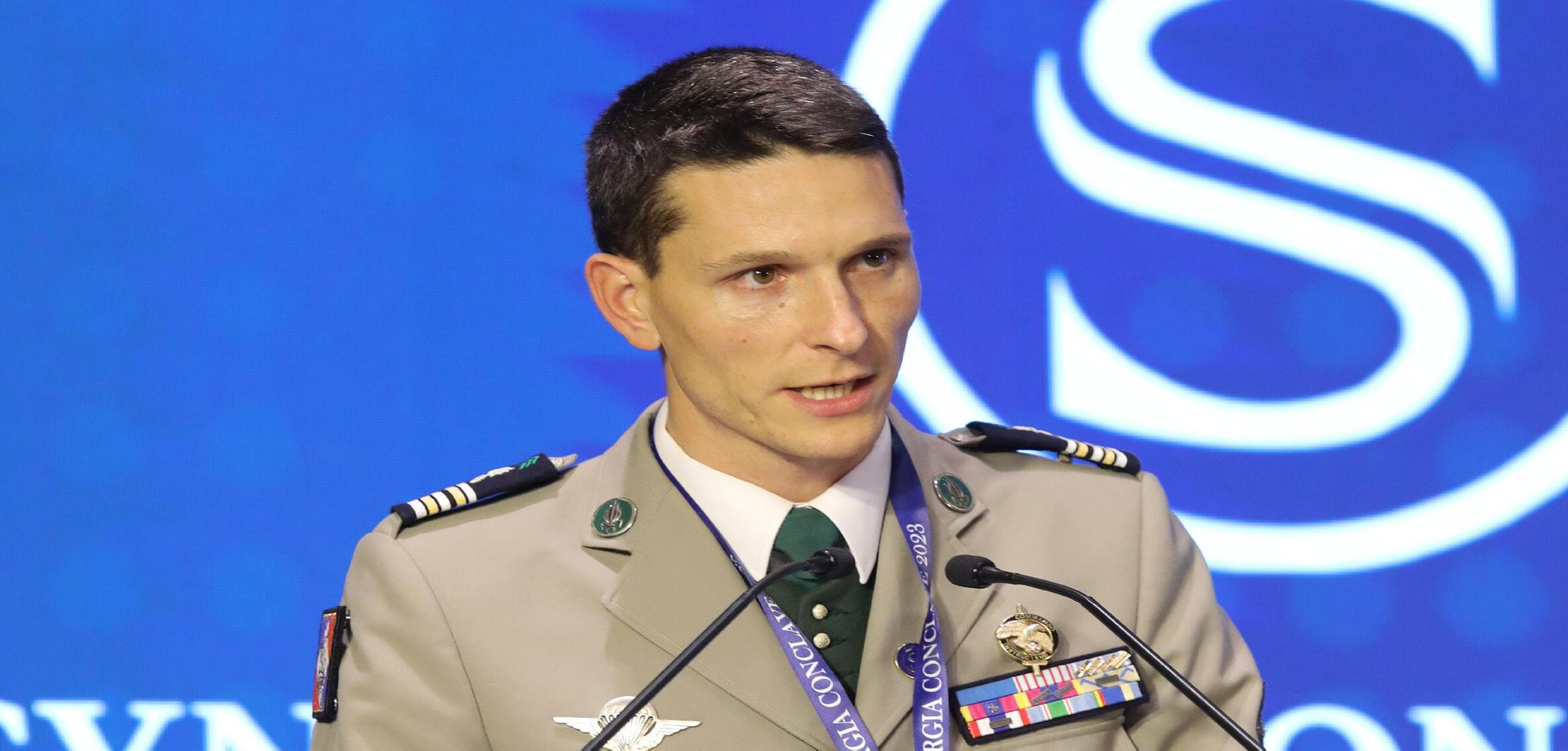

WARFARE AHEAD: CONFRONTING FUTURE CHALLENGES
Future conflicts will probably be more complex, more lethal and more contested.

There is an idiom in French attributed to the famous emperor Napoleon that says impossible does not belong to the French language. Beyond encouraging boldness and imagination, it underlines, when applied to strategic thinking, the need to think about strategy and thought and prepare for the unthinkable.
Foresight and anticipation are difficult exercises but essential strategic functions for navigating a volatile, uncertain, complex and ambiguous world. Primarily, armed forces must anticipate being ready for warfighting tonight while acting daily to win the war before the war really happens.
THE TRIPTYCH OF MODERN WAR
Klaus Witt’s metaphor of war as a chameleon, ‘War’s nature endures, though the character of war evolves permanently,’ endures to date. If we fail to understand this evolution and dynamics, we are condemned to prepare to fight for the previous war. The classical continuum of peace-crisis-war has shifted to a triptych composed of competition, contestation, and confrontation.
Discrete analysis bears a more realistic vision of competition as the normal state of relationships between states. This implies a necessity to act and influence as of the competing stage. The military effects are not limited to warfighting. Contesting actions under
The tenets of modern warfare make alliances and partnerships all the more necessary. Exploiting the tool of military cooperation, partnerships only may provide an answer to complexity through complementarity and shared awareness, to lethality through the principle of mass, and to contest through strategic depth and strategic solidarity.
the threshold of conflicts and hybrid strategies in the green zone require that the force have a strategic effect to influence the auditor before a confrontation. That is what the French Joint Chief of Staff calls winning the war before the war.
However, the coexistence of these three states of relations implies that we must be ready to intervene in a major war that we did not choose to fight if an adversary decides to go beyond the contesting stage to reach a decision by force.
In this context, future conflicts will probably be more complex, lethal, and contested.
First, wars will be more complex. Warfighting domains have extended from three to six or seven in the French case in the past years. Land, sea, air, space, cyber, electromagnetic and information or cognitive domain. This extension complicates the interaction between actions in each of these domains that provide physical and material effects that must be integrated. The strat-
SYNERGIA CONCLAVE 2023
This article is based on the round table curated by Lieutenant Colonel Pierre Néron-Bancel, Army Officer of the Centre for Security Studies, IFRI, France, on Warfare Ahead at 9th Synergia Conclave 2023.
egy must become more holistic since warfighting has invaded all the fields of human activity, such as finance, information, energy, and food supply. Hybrid strategies add to these complexities, making situation awareness and understanding more difficult.
The second tenet of future warfare is lethality. Western armies are preparing for the return of high-intensity conflicts, what we used to call major wars. Such warfare is characterised today by unprecedented battlefield transparency, a predominance of fires optimized by hyper-connectivity and data fusion. All these factors increase the attrition rates, advocate for the quality of numbers, and underline the challenges of human resources, ammunition supply and stocks, armies and nation resilience, and potential regeneration. The Ukraine war epitomizes this rate of attrition with, for example, more than 3,000 main battle tanks destroyed, damaged or captured by the two sides during the 20 months of the war.
Last, wars will be more contested. We are living at the end of the Western operational comforts and air supremacy with the development of anti-access, anti-air denial capabilities and the ability of even medium powers to contest what we call the commons. The past years have witnessed more powerful non-state actors displaying techno-guerrilla capabilities that can undermine high-tech combat forces’ superiority. For example, contestation of the freedom of navigation will be a major threat in the years to come.
On another aspect, our modern societies are increasingly reliant on digital technology, hence more vulnerable to cyber-attacks. Eventually, our narrative and values will be increasingly contested in the information domain through disinformation and counter-narratives levered by the potential of digital technologies. This evolution of warfare will foster many challenges to overcome. Challenges, for example, to access and endure on the battlefield. Challenges of understanding, transparency and surprise, challenge of connectivity and command and control, challenge of aggression and protection of the force, challenge of autonomy and human responsibility, and last example, challenges of industrial and national resilience.
THE FRENCH PERSPECTIVE
Strategic autonomy is the core concept of French strategic posture, understood as the autonomy of sovereign decisions and actions. There are three key te nets of autonomy-knowledge for decision, the means for action, and the partnering posture. French security strategy identifies knowledge, understanding, and anticipation as keys to strategic functions and is un derstood as the means for an au tonomous assessment capability.
It includes intelligence, diplo macy, anticipation, knowledge about theories of operations and informa tion management. The armed forces
contribute to collecting low early warnings and identifying patterns and intents to assess when a threshold has been crossed. This is particularly critical in environments where threats are not easily attributed and play on ambiguity to create fait accompli. Border and national air and maritime space control, monitoring of satellites and debris in space, cyber defence or involvement in maritime domain awareness multinational initiatives are good examples of implementing this priority.
The complexity of modern warfare requires first to upscale our combat tool to a strong and credible full-spectrum military capability, which is fit for largescale combat operations and high-intensity warfare. France aims to develop a credible, well-balanced, coherent armed forces model capable of acting across the entire spectrum of conflict, integrating effects from and to all warfighting domains and aiming at dominating every domain, including the non-kinetic environments, especially the information domain.
Key organization qualities are robustness and endurance, but a high level of agility is required to respond to an unexpected crisis. A strong and resilient defence industry is another key requirement to face the demands of high intensity and long-term dominance. Developing the defence industry requires focusing on the biggest partners and the tens of thousands of SMEs that contribute to the national effort for defence and security. This priority to strengthen the industrial base through diversified supply networks, protected industrial ecosystem and funded R&D is a shared concern with the Indian defence. This effort requires a confident partnership between the armed forces and the defence industry.
The tenets of modern warfare make alliances and partnerships all the more necessary. Exploiting the tool of military cooperation, partnerships only may provide an answer to complexity through complementarity and shared awareness, to lethality through the principle of mass, and to contest through the strategic depth and strategic solidarity. This explains why the French armed forces make strategic solidarity the heart of their posturing.
NATO comes first as a foundation and the framework of Europe’s collective security. Beyond NATO, though, France aims to partnerships dedicated to responding collectively to crises and risks. This partnering posture calls for interoperability, bonds of trust, confidence, and shared interests. The Indo-Pacific region perfectly embodies how shared interests for a free and open Indo-Pacific area contribute to stability through dynamic and multifaceted partnerships. The level of collective effectiveness depends on credible nation-leading framework capabilities that only a comprehensive defence model may foster.

25 WARFARE AHEAD: CONFRONTING FUTURE CHALLENGES




ALGORITHMIC WARFARE: AI’S PROMISE & BOUNDARIES
As far as risk mitigation is concerned, there is no one-size-fits-all solution.
This article is based on the discussion curated by Lieutenant General RS Panwar, Former National Cyber Security Coordinator, India, on Responsible AI at 9th Synergia Conclave 2023.
Artificial intelligence as a term eludes definition. However, the general agreement is that it is a broad spectrum of technologies. The primary amongst them is neural network-based AI ML technologies, others being rule-based programming used in expert systems, statistical techniques, etc.
There are characteristics of the technology per se, such as the opaqueness of AI ML systems, the brittleness of those systems, and unpredictability because it can learn directly from data, which we call online learning.
And, of course, the intelligence that AI ML and other AI systems endow to machines. What is of concern is the intelligence that it endows to machines, which leads to handing over more and more autonomy to machines.
This is what causes concern when people like Elon Musk, Stephen Hawking and Sam Altman say that there is an existential risk with AI technology.
This is intelligence. When these technologies are used to create applications, it leads to different risks. Firstly, the EU-AI Act has tried to list all the technologies.Secondly, it has come up with a risk-based approach for addressing civilian applications. Human rights issues, such as racial and gender bias, right to
It does not make sense to
paint the full gamut of AI-enabled military systems posing widely different risks with a common brush by instituting identical mitigation measures for all. We need a differentiated risk mitigation mechanism, which must be evolved and fine-tuned to each risk level.
privacy, etc, often drive AI-related concerns in civilian applications.
UNDERSTANDING AI RISKS
Risks in AI-enabled military systems emerge from the twin considerations of adherence to international humanitarian law and reliable performance on the battlefield. As far as risk mitigation is concerned, there is no one-size-fits-all solution. Therefore, there is a need to adopt a risk-based approach.
The previous EU AI Act has also adopted a riskbased approach in connection with civilian applications. The risk posed by a wide spectrum of AI-powered military systems, comprising weapon systems and other military applications can be evaluated and addressed at a more granular level.
Towards this end, a five-level hierarchy is based on an intuitively appealing rationale. The top three levels pertain to weapon systems, and the bottom two to AI
SYNERGIA CONCLAVE 2023
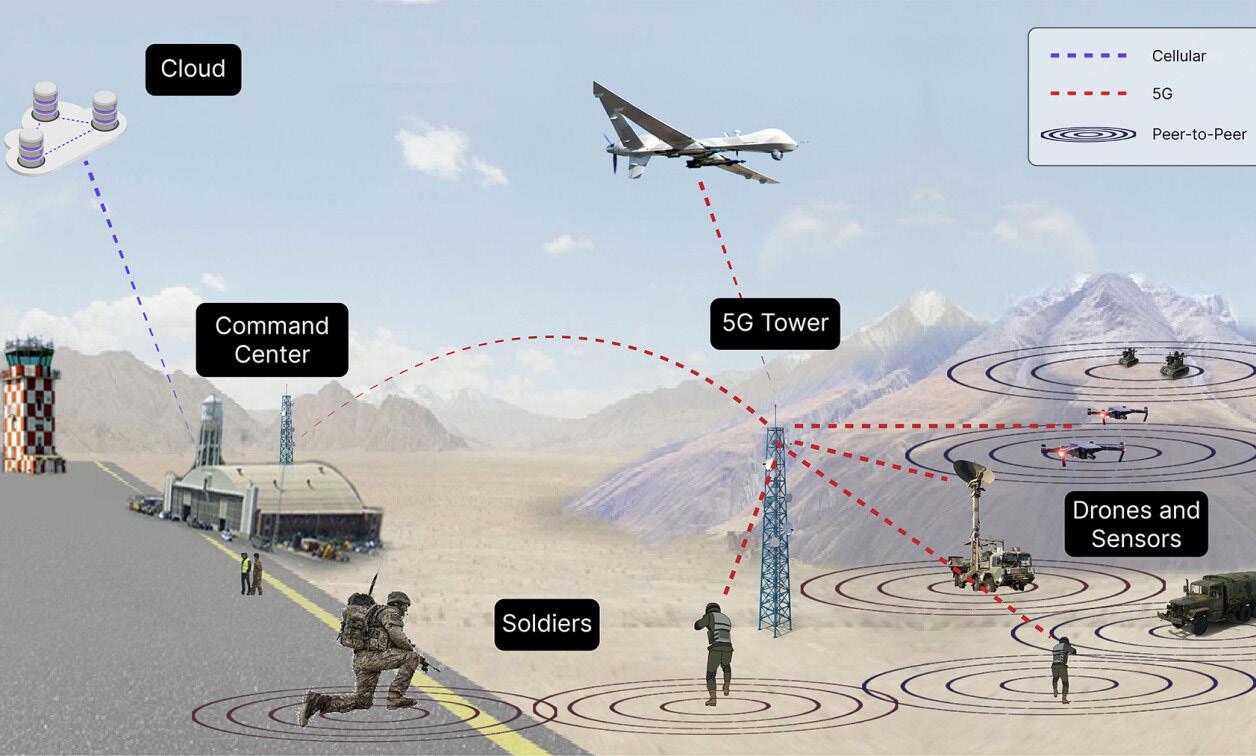
military applications, which are collectively referred to as either non-weapon systems or decision support systems.
Then, a simple yet effective mechanism is used for mapping real-world military systems applications into these risk classes. These risk classes can then be subjected to mitigation measures tailored to each class.
The risk hierarchy evaluates risk based on certain criteria that reflect the driving concerns, such as reliability under the battlefield and international humanitarian law, such as level of autonomy, whether it is lethal or anti-material, its destructive potential, etc.
EVALUATION PARAMETERS
Fully autonomous lethal weapon systems are placed at the highest risk level. Fully autonomous are weapons capable of selecting and engaging targets without human intervention.
The Israeli Harop is a good example of such a system. It is a loitering kamikaze drone that hovers around in the area of operations. When it detects the right radar signal, it dives down and destroys the target.
Now, the twin effect of its two features of autonomy and lethality puts all systems in this category in the high-risk category.
A fully autonomous nuclear weapons system is an obvious candidate for the unacceptable risk level at the top of the risk hierarchy because of its extreme destructive potential.
Now implied in such a cate gorization is also that such a system should not be devel-
oped at all. After all, it poses an unacceptable risk.
Another class of systems that the risk hierarchy places at this level are fully autonomous online learning systems, weapon systems that might learn while in operation and, as a result, display unpredictable and unreliable behaviour. As yet, such systems are not known to exist.
At the lower end of the spectrum of weapon systems in the risk hierarchy are defensive anti-material systems; firstly, they are defensive, and secondly, they are anti-material, not lethal.
Even though these may be fully autonomous, such as the U.S. Phalanx close-in-weapon system or the Israeli Iron Dome, which are designed to destroy incoming rockets and missiles. Because of the design and nature of the employment of such weapons, they cannot cause unintended harm to human lives.
All semi-autonomous weapons would also fall in this category since these are always under full human control.
It does not make sense to paint the full gamut of AI-enabled military systems posing widely different risks with a common brush by instituting identical mitigation measures for all.

We need a differentiated risk mitigation mechanism, which must be evolved and fine-tuned to each risk level.
These could vary from a complete ban at one end of the spectrum through different levels of scrutiny, legal review, test and evaluation procedures, mandatory use of explainable AI, etc.
27 ALGORITHMIC WARFARE: AI’S PROMISE & BOUNDARIES


TRUSTWORTHY AI
As far as risk mitigation is concerned, there is no one-size-fits-all solution.
At its core, AI assurance is about recognizing and mitigating the risks of AI-enabled military systems. AI assurance is a crucial part of all AI development.
It combines two things- the principles of test and evaluation, or T&E, and the tenets of responsible AI. AI assurance is applied at all stages of the AI lifecycle. Across the world, the number of terms may differ, and the exact word itself may differ. But generally, the principles are the same - responsible, equitable, traceable, reliable, and governable. Even while AI is viewed as software, testing and evaluation are as important for AI-enabled systems as for any other hardware or software system in the military. The goal is to ensure that AI systems are trustworthy.
An AI-enabled system is trustworthy to the extent that, when used correctly, it will do what it is supposed to do. Two, when used correctly, it will not do what it is not supposed to do. And three, humans can dependably use it correctly. The last one brings in the considerations of human-machine teaming. This theme will be one of the most crucial things we must work through in defining those interdependencies, responsibilities, and roles between machines and humans over the next decade.
Many aspects of AI testing resemble testing of all other military systems. The same fundamental systems engineering principles apply. However, some significant differences must be considered when developing, testing, fielding, and sustaining AI systems.


At its core, AI assurance involves recognizing and mitigating risks in AIenabled military systems, combining principles of test and evaluation with responsible AI, ensuring trustworthiness throughout the AI lifecycle, and addressing unique challenges such as sustainment, adaptation, explainability, and data integrity.
Sometimes, that sustainment part is neglected, which may be one of the most important when you are talking about AI systems.
• The difference in how models are trained and how they perform once they are fielded is important. What we call mission or domain-specific adaptation includes the very real possibility of distribution drift, seen in models when fielded in the Department of Defense.
• Unanticipated or unknown failure modes. The need for explainability, auditability, and predictability. And related directly to this idea of sustainment, what we call continuous integration and continuous delivery. If you’re not updating your AI models every month, they’re getting too stale.
• And then the risk of skewed, corrupted, and incomplete data sets in all varieties of adversarial attacks. When you compare traditional hardware or software systems with AI-enabled systems, roughly 70 per cent of tests and evaluations are the same. And, of course, we cannot consider AI’s limitations and technical risks in isolation. We also need to address policy and legal matters.
SYNERGIA CONCLAVE 2023
This article is based on the round table curated by Lieutenant General John Shanahan, Retired US Air Force, on Trustworthy AI at the 9th Synergia Conclave 2023.


AI AND THE LAW: WHERE PATHS COLLIDE


New technologies, however impressive, will never eliminate the fog, friction, and chaos of war.
This article is based on the round table curated by Dr. Ibin Yede, Assistant Professor, Royal Danish Defence College, Denmark, on AI and the Law at the 9th Synergia Conclave 2023.
Is responsible AI an oxymoron, or whether responsible use of AI is an oxymoron? Technology cannot be held responsible for the follies of humans. It is the use of that technology because any technology can be both good and bad, depending on how the humans using it behave and what their intentions are.
OLD WINE IN NEW BOTTLE?
There are many legal concerns related to responsible uses of AI in the military domain, with many issues resembling the concerns that occur in the commercial use of AI. However, working for the military and being in the business of killing people and blowing things up, the risks are different. Also, the applicable legal framework is different. We are primarily guided by international humanitarian law (IHL) that regulates the conduct of facilities, namely the rules for how you can use force, when you can do it, against what targets and under which precautions.
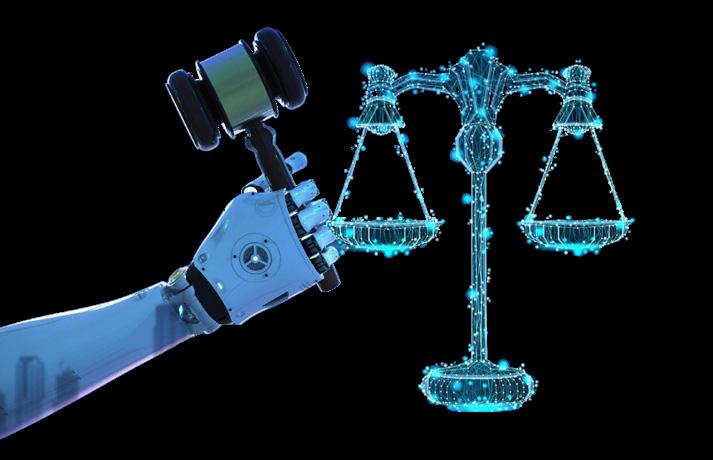
We have moved beyond discussing whether these rules apply at all. That was the starting point of the discussions because we were dealing with very old rules that do not explicitly address AI. Now, every-
Considering the object and purpose of international humanitarian law, which is to lower the suffering of those subjected to armed conflicts, we are perhaps obliged to use technology whenever that can be used to make us more precise and lower collateral damage.
one agrees that it does, like in the cyber domain; it is all about figuring out how we apply those rules to this new technology.
This means that when we create AI-enabled weapon systems, we have to make sure that they can be used in accordance with the key rules of distinction, proportionality, and precautions in attack.
New laws must ensure that both commanders’ intent can be followed by the system, which should be capable of correctly identifying lawful targets in accordance with principles of proportionality and precautions. All AI-enabled systems must undergo a legal review before they are fielded, which can get tricky because of the nature of AI-enabled systems and their complexity.
The third effect of IHL being applicable is that a military decision-maker who decides to use an AI-enabled system for a particular attack is responsible for that decision, just like he or she is responsible for deciding to use a hellfire missile fired by a drone or a sniper. So, there is no responsibility gap. The fact that IHL does
SYNERGIA CONCLAVE 2023

not specifically mention AI-enabled weapon systems but has rules that are human-centred does not mean that they are per se prohibited or not prohibited; there is no explicit prohibition.
The rules that we have currently do not stand in the way of using AI-enabled systems, at least not in all circumstances. Considering the object and purpose of international humanitarian law, which is to lower the suffering of those subjected to armed conflicts, we are perhaps obliged to use technology whenever that can be used to make us more precise and lower collateral damage.
CHALLENGES
There might be a positive obligation to ensure better solutions using AI-enabled technology. But there are three overall challenges.
The first one is the control problem. How do we ensure that systems can be used in accordance with the commander’s intent and international humanitarian law? When a human being is not necessarily pulling the trigger, this problem becomes even more difficult considering the combination of AI systems’ brittleness and the dynamic nature of modern battlefields. You might train a system to perform well under certain circumstances, but as soon as circumstances on the ground change, the system might have difficulties acting correctly. So, how do commanders and legal advisors ensure we can control the system?
The second overall problem is the black box problem. The complexity of these systems and the fact that machine learning and neural networks per se are not explainable and transparent makes it very difficult for us to understand how the system translates the input into output. From an IHL perspective, that is challenging because we like predictability and reliability, and how can we establish that when we don’t understand the parameters for the algorithm’s decision-making?
And the third challenge is the accountability challenge. The further away from actually pulling the trigger a person is, the harder it can be to attribute any unlaw-
ful acts committed by using an AI-enabled system to an individual. There are several competing regimes. You can have the commander with responsibility, but there might also be production flaws and design flaws that could lead back to product liability.
You could have state responsibility. States are always responsible for war crimes committed by them, regardless of the means they’re using. There are competing regimes, and identifying the correct one might prove difficult.
New technologies, however impressive, will never eliminate the fog, friction, and chaos of war. Despite all rules and regulations, a specific chain of events can lead to terrible consequences, beginning with system design and development all the way through updating or not updating the model in the field.
Different actions at every step along the way can prevent tragedy. The data used should be sufficiently representative of the operational environment. Second, rushing the system into fielding without sufficient testing evaluation.
Humans can and do catch a lot of problems, but it becomes much harder, perhaps even impossible in some cases, to do so once a weapon system is automated fully. For AI models, this is an important point. Testing never ends.
THE WAY AHEAD
Probably 98 per cent of commanders in the field right now do not fully understand how AI models work. They do not comprehend the AI model’s limitations and possible failure modes. They also did not grasp the implications of removing humans from the final targeting decisions.
Better training would help in this regard, both for military commanders and, equally important, for civilian policymakers who should be armed with questions to raise so they could press the military for better answers. A lack of technical understanding is not an excuse when bad things happen on the battlefield.
The U.S. military and, indeed, the militaries of every nation want to deploy AI to help them to assure and deter and, should deterrence fail, to prevail in conflict. That is what national defence and security are all about. Everybody wants to gain a technological edge. Still, some aspects of transparency are compatible with national security, such as consensus on the principles of AI assurance, a risk framework for AI-enabled military systems and some non-proliferation agreements.
We are entering a new, somewhat uncharted world with AI-enabled systems. If an AI-enabled military system fails, there will be serious consequences not only for the two sides involved but globally as well. It is possible to maintain operational security and not reveal sensitive capabilities while taking steps internationally to ensure AI’s safe, lawful, and ethical use.
30 AI AND THE LAW: WHERE PATHS COLLIDE

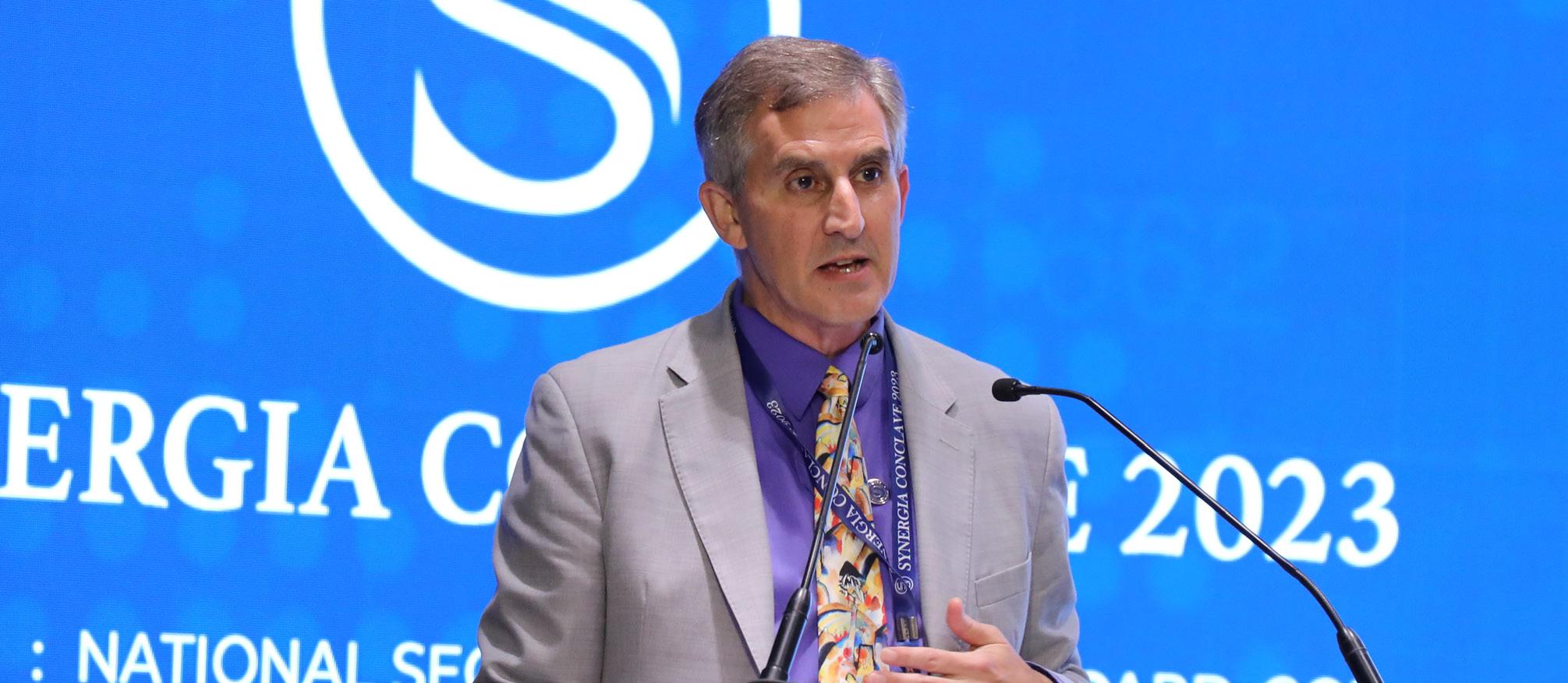 MR ERIC RICHARDSON
MR ERIC RICHARDSON
RESPONSIBLE AI
For the past five years, I have been leading a team of colleagues engaged in international AI dialogues with experts. Our discussions have reached one clear conclusion: There is no one-size-fits-all answer to address AI in military systems. Rather, you need to understand the risks and mitigate, regulate, or control these risks. An integrated team of experts has been advising governments and discussing with other international colleagues what responsible AI in the military means.
In 2018, we started AI mediation in Beijing and Washington. Our theory was simple- the AI superpowers together, and if they can agree on voluntary agreements to limit AI, then we can move on to add other experts from India, the EU, Russia, and other halves of the AI world.
It was not easy, but we have succeeded in large measure. Some of you may know acronyms like the GGE (Group of Government Experts) and the CCW (Convention on Certain Conventional Weapons), discussion group is now discussing lethal autonomous weaponssystems in the UN. We decided to start in the area of track two agreements, establish some momentum and trust, and then build from there. So, our approach was minilateral and voluntary rather than multilateral in a consensus-based system without consensus. We have had some significant agreements.
One of the highlights of this five-year effort came just last week, when we saw Presidents Biden and Xi meet at the APEC summit in San Francisco and discuss the issues of AI safety and risk that we put on the table through experts in both Washington and Beijing.
RISKS OF MILITARY AI?
Regulating AI does not start with a campaign to ban killer robots or figuring out a whole category of weapons to ban, but rather to look at specific risks and mitigate for them-human control, accidents, safety, explainability, or even protecting civilian technologies
from over-regulation are among the risks in that space. Considering risk mitigation, consensus was found at least four areas -principles, specific limitations, tests and evaluation standards, and training standards.
Work remains to find consensus on export controls on dual-use technology like AI embedded in military platforms. Work is also being done on using what we call ‘AI for Good in warfare’ because AI can be helpful to ensure that fewer combatants are killed, targeting is accurate, and key civilian infrastructure like schools and hospitals is not targeted.
Two of our biggest successes are two documents available on the INHR website. One of them is a code of conduct, which was published in 2021. The second is an AI military test and evaluation model practices guide, which was agreed upon earlier this year due to a workshop in Copenhagen hosted by Dr Iben Ida and the Royal Danish Defense College.
The Best Practices Guide looks at how to test and evaluate AI systems to determine whether data is used correctly, avoiding data corruption. It ensures that testing achieves the effectiveness and safety designed for. In case of an accident, lay down the investigation process and corrective action. One possible model to be adopted is the one followed by the International Civil Aviation Organization and domestic aviation organizations, where sovereign states give up some of their sovereignty to make sure that there are internationally believable and reliable investigations in a context that is likely to impact people across borders when there are aeroplane crashes.
The code of conduct agreed in 2021 sets out a series of confidence building measures states can take to ensure that their design, deployment, and international cooperation in AI weapons improves and gets safer. A few examples include marking an asset’s autonomy level, declaring certain politically sensitive locations off limits to untested or insufficiently tested AI-enabled weapons or committing to avoid civilian infrastructure like schools and hospitals entirely.
SYNERGIA CONCLAVE 2023
former U.S. diplomat and a professor of law at the University of Michigan and the University of California, Berkeley Law Schools.


RESPONSIBLE AI
How do you train these systems to ensure they conform to certain patterns of behaviour and accuracy and data?
Almost a year ago, this phenomenon around OpenAI, Chat GPT and many other things to do with GenAI, as we now call it, started to hit the headlines. It was a proverbial tipping point for AI, which many people said was in the midst of a ‘funding winter’ for a long time and had suddenly come alive all over again. Now, statistics talk of incredible numbers to the tune of trillions of its market potential and the promises and, at the same time, the perils of embracing this opportunity that has been unleashed upon humankind.
Gen AI is multimodal in nature- there is text, video, voice, and all possible permutations and combinations out there. If you reflect on technology over the last several decades and think of a paradigm shift, this is well and truly one. However, building on the word ‘responsible’, there is a lot of concern about whether creativity should be regulated. If so, how? What exactly do you mean by guardrails? What are the implications on intellectual property? How do you redefine security? What is the veracity of all that comes out? And how do you make sure that it is controlled, configured, and administered accurately? Many of these questions have been around for some time. There are ethical norms now being spoken of in respect of GenAI. Should the same ethical standard not have been imposed ten years ago, or even 50 years ago, on anything to do with technology that was mechanistic, automated, or autonomous?
Mankind stands on the cusp of not just human labour, the physicality of what we do in society or industry, getting out-tasked or outsourced to machines. There is an element of cognition that is now surfacing. And in trying to capitalize on that cognition that gets out-tasked or outsourced, the gravity of an ethical approach to GenAI gets amplified much more. Therefore, what is Responsible AI all about - accountability, risk, culture, equity, intellectual property? It is amazing how many digitized atomic elements of what constitutes re-
sponsibility are out there. As we have evolved over so many thousands of years, there has always been legislation, rules to the game, behavioural dictates, and so on that have evolved.
How do you impose this? How do you train systems to mimic what we have brought forth through governance, risk, compliance and other measures? That, in brief, is the problem statement when it comes to the applicability of AI and the origin of AI.
The other thing to note is a consumer phenomenon. Most people have tried out something to do with chat GPT or some of the other more intelligent search engines are starting to emerge. Enterprises at the board level are grappling with two things. One is the fear of missing out. How do you rapidly adopt this and bring about exponential gains, which surely is what every enterprise seeks to do? And somewhere between the consumer and the enterprise or the corporation lies society and the mechanics of what this is.
Regarding guardrails, how do you train these systems to ensure they conform to certain patterns of behaviour and accuracy and data? That is all part of the responsible AI charter. It is a very nascent phenomenon. The game is still evolving. Indeed, what GenAI has to offer is yet to be seen. But the evolution of this is something certainly well upon us.
This brings me to what I call a 1.0 avatar of a playbook. When we look at the conversations we have with our customers today, it is all about how it’s good you are embarking on an AI initiative, it’s good you’re consuming the latest and greatest when it comes to GenAI.
But in doing so, how do you ensure all these guardrails, the context, and the risks, and how do you engineer to ensure that they are controlled? What buttons do you have to bring it under control if it goes out of control? And where do you draw that fine line between the art of the possible in terms of harvesting or exploiting this tech? At the same time, just be controlled and calibrated so that you don’t end up taking orders from it.
SYNERGIA CONCLAVE 2023 32 RESPONSIBLE AI
MR SIVA GANESH Global Head, TCS Cloud AI Unit




GLOBAL TRENDS: TRANSFORMING TOMORROW
“For the first time, we are looking at the potential for global conflict on a scale of World War II.”
TThis article is based on the address delivered by Air Vice Marshall
John Finbar Monahan,
Director Defense Concepts and Doctrine Center, MOD, UK, on Global Strategic Trends at the 9th Synergia Conclave 2023.
he Major driver influencing the global strategic trend is Demographic Pressure. For example, by 2055, two-thirds of the global births will occur in Africa. That underlines the importance of the global South, a very expanding population. Meanwhile, other parts of the world will have ageing populations, which also comes with all sorts of pressures, as experienced in Europe.
Climate change is yet another driver. There are very important implications for climate change. There are opportunities in climate change that can trigger a shift in the balance of power in the world. For example, China produces the most solar panels while India produces the cheapest solar panels in the world, and we see a shift, therefore, in leverage that is available to nations.
Meanwhile, 70 per cent of the lithium for batteries lies underneath the land of Latin America. So, we see a shift away from the traditional oil-based economies to other areas of the world. What does that mean?
GLOBAL DRIVERS OF CHANGE
The aerospace and cyber domains are undergoing very rapid changes in the world. Many actual and potential adversaries are positioning themselves to exploit both these domains. Operating below the threshold of
The next world that we have is changing spheres of influence. This is a world in which we see increasing multipolarity and competition. We are experiencing a multipolar world breaking into a situation akin to the great game of the 1800s, in which major nations compete. This does make the future look fairly uncertain. For the first time, we are looking at the potential for global conflict on a scale of World War II
armed conflict, they wish to exploit legal loopholes that do not exist in these two domains but exist in the more traditional domains of the land, the sea and the air. However, the connectivity issue presents challenges; 95 per cent of the internet on which most data flows actually still relies on undersea cables.
Space is increasingly being used to deliver internet, but with the increased use of space will come the congestion of space. Therefore, vulnerabilities to our access to data will remain a major concern for some time.
Today, economic transformation and energy transition are enormous. Fighters are being flown on synthetic aviation fuel. Small nuclear reactors are being designed that are re-deployable, allowing energy to be produced anywhere on the earth. This will relieve expeditionary forces from the tyranny of the logistics chain for fuel if the force can generate its fuels from
SYNERGIA CONCLAVE 2023

its rubbish, it can be liberated from the stranglehold of carbon-intensive fuels. As richer and more technologically advanced countries delve deeper into space, ocean depths and the medical spectrum, we see massive inequalities emerging as not every human will have equal access to these expensive technologies. However, there has been democratisation of information particularly with the mobile phones.
That is going to increase, and people are gradually going to become more aware of the inequalities that they suffer. That is significant as the state will face an increasing tempo of challenges from the people.
Information has become a tool of war, as we saw in Ukraine, where Elon Musk’s SpaceX spontaneously stepped in to provide satellite internet access to war-ravaged Ukraine. Later, just as abruptly, Space X decided to turn off the internet. Now, we are witnessing large corporations taking sides in global international relations. Global power competition was never so stark as it is today; there is an ongoing major war in Europe, Gaza is in flames, and the Chinese are indulging in the biggest military build-up since World War II. For the first time in many years, there is a much-increased chance of state-on-state conflict.
With all these drivers of change occurring almost concurrently, we can construct global strategic trends. These can be built into regional spaces but also refer to shared spaces. The future is not linear; it is complex and particularly at this moment in time, we see it as being very turbulent.
What are the paths that the world can take-multilaterism, multipolarity, fragmentation or network of actors?
FICTIONS FROM THE FUTURES
A recognised futurology technique called ‘fiction from the future’, tries to build a series of tangible futures or worlds. None of them may come true in their entirety, but they allow our strategic planners, the peo-
ple who develop our capabilities and the people who plan for our military, as well as our other government departments, to test against their strategies and theories.
The current world order was developed under the aegis of the Bretton Woods conference, which we observe as ebbing and flowing with the turbulent currents of geopolitical events. The next world that we have is changing spheres of influence. This is a world in which we see increasing multipolarity and competition.
We are experiencing a multipolar world breaking into a situation akin to the great game of the 1800s, in which major nations compete. This does make the future look fairly uncertain.
For the first time, we are looking at the potential for global conflict on a scale of World War II, considering the amassing of fighting power in China and the challenges to the world order and multipolarity that are taking place. Another scenario is one in which there is incremental instability; the network of actors becomes increasingly complex, including organised crime, radicalism, and the rising geopolitical power of major corporations that have a real influence on international relations. It is a world with a networked order, which is unstable, actually bumping along, and quite problematic.
CONCLUSION
All nations have choices to make for their future. The issue is, what is it that we want to drive for? What is it that our leaders want in the world? And that is one of the big questions we pose in global strategic trends. That leads the military to highlight the issues of the world with global strategic trends and allows our decision makers to start to understand that we want to be driving for X or Y. Next comes the military concepts that allow the military to deliver the capabilities needed for the future; these capabilities must strike a balance between the exquisite and what is available in mass and is affordable or off the shelf.
34 GLOBAL TRENDS: TRANSFORMING TOMORROW

STIRRING UP OF BLOOD TIES!


The Indian diaspora in South Africa is undeniable, but do they have the bandwidth to act as a bridge with their mother country?
 Diya Celine Simon Research Associate in Synergia Foundation with a Bachelor’s in Media and Communications, English Literature and Psychology.
Diya Celine Simon Research Associate in Synergia Foundation with a Bachelor’s in Media and Communications, English Literature and Psychology.
The roots of the Indian diaspora in South Africa go back to the 19th century. In the 1860s, Indians from Tamil Nadu, West Bengal, Andhra Pradesh, Bihar and Uttar Pradesh were brought to South Africa as indentured labourers for a five-year term to work in farms and mills. At the end of the contract, Indian immigrants were offered either to return to India or a piece of land. Only a small percentage chose to return, while others set up small businesses in cities like Durban, KwaZulu-Natal and Cape Town, becoming “free Indians” and marking the beginning of a blooming Indian population in South Africa.
The second wave of Indian immigrants in the 1880s were called ‘Passenger Indians’, who paid for their tickets to South Africa. Among them was Mahatma Gandhi, who failed to further his legal career in India and went in 1893 to assist with a legal matter. He found that Indians were treated only marginally better than Black Africans, and Gandhi’s experiences were enough to drive him to unite and educate the Indian population. The well-known Satyagraha movement in 1906 symbolised his drive to represent Indians on the foreign land and stand up to racial subjugation. The movement challenged the then-South African coloniser government in its blatantly racist governance, like denying trading licenses to Indians and imposing a three-pound tax on
Both India and South Africa come within the somewhat safe yet dangerous range on the Countries Safety Index. Security challenges in South Africa include high crime rates, armed insurgencies and social cleavages that directly relate to political corruption, and widespread unemployment and poverty. Governance deficits, political conflict and electoral violence also affect the consolidated democracy of South Africa.
all “free Indians” to force them to re-indenture or leave South Africa.
The Indian population became the foundation of a middle-class community and helped development in Natal. However, the struggle to be accepted became harsher over time. Indians felt more outlier and estranged because of how deeply racial discrimination was ingrained into the entire population. At a civilian level, native South Africans could not relate to them entirely because of the concept of Indians being “free” at some point. But at a political level, the Gandhian philosophy of mutual respect, tolerance, unity and non-violence brought about a peaceful transformation in South Africa. It impacted the struggles against poverty, homelessness, sustainable development, and inequalities of apartheid and colonialism.
GLOBAL SCAN

India was always at the forefront of anti-apartheid movements in South Africa. It was the first country to sever ties and impose economic sanctions and trade embargos on South Africa’s coloniser government in 1946. South Africa may have gotten its independence on 31 May 1910, but the first democratic election in the country took place between 26-29 April 1994. South Africans celebrate their Freedom Day on 27 April to commemorate the radical change that occurred nearly 85 years after independence.
DIPLOMATIC RELATIONS
During the apartheid era that ended in 1994, all Indian passports were stamped with the dire message, “Not valid for South Africa.” This diplomatic boycott, observed by the bulk of the global community, ended with the demise of the apartheid system in South Africa. India and South Africa resowed the seeds of diplomatic relations with The Red Fort Declaration in 1997 between then-Indian PM Shri Deve Gowda and then-South African President Nelson Mandela. Then, the Tshwane Declaration in 2006 fertilised the soil for their strategic partnership. Both countries are closely associated with multilateral organisations like IBSA and BRICS.
TRADE AND INVESTMENTS
India and South Africa’s bilateral agreements encompass economic and commercial cooperation, defence and public administration, health and education, culture and human settlements, and science and technology. After the formation of the India, Brazil and South Africa (IBSA) forum, trade between the two countries increased substantially. According to a study on India-South Africa Bilateral Trade, total trade between India and South Africa increased by 16.5 per cent per year between 2000-01 and 2018-19. India exports commodities like railways, tramways, machinery, nuclear reactors, mineral fuels, oils, distillation products, pharmaceuticals, food, grains, etc. South Africa exports materials ranging from mineral fuels, oils and distilla-
tion products, ores slag and ash, iron and steel, coal, nickel, copper, etc, to electrical machinery and parts, precious stones, food and leather, the pulp of wood, fibrous cellulosic material, and waste.
Trade and investments run deep between the two as India is the second largest trading partner of South Africa from the Asian subcontinent. In 2022, India’s exports to South Africa were US$ 8.47 billion. South Africa’s exports to India were US$5.23 Billion, a 4.29 per cent share of South Africa’s total exports. Concurrently, India’s imports from South Africa were US$ 10.39 billion, and South Africa’s imports from India were US$8.33 Billion or a 7.44 per cent share in total imports.
SOCIAL SYSTEM
The present President of South Africa, Thabo Mbeki, states that Gandhi’s legacy is rooted in the heartbeats of his people. But despite the common trend of attributing Indian ties with South Africa to Mahatma Gandhi, fourth-generation and beyond South Africans of Indian origin do not associate with the Indian hero much. Access to their ancestral ties recently opened up to the South African population, and it is only now that they ask about where they came from.
Both countries share similarities and sentimental bonds through their cultures, experiences and freedom struggles. Both countries link on both ends of the spectrum of experiences like intense coloniser experiences, racial segregation, rapid and sporadic industrialisation, apartheid, and exploitation of regional resources to diverse cultures of art and music, tradition and community closeness. Literacy rates in South Africa since the 2000s have risen from one-fifth to four-fifths of the population. Since the early 1900s, South African native and coloured migrant populations have progressively begun occupying higher positions across various fields, while more white populations occupy mid-tier positions. According to Statistic’s 2017 mid-year population estimates, the Indian population in South Africa
36 STIRRING UP OF BLOOD TIES!
is around 2.5 per cent of the total population. In 2023, Reineth Mgiba, Director of the Department of Higher Education and Training in Pretoria, stated that being a part of BRICS meant that South Africa and India help each other with overall development. The Indian-South African community is known to be highly urbanised, contributing as the 2.8 per cent economically active community and holding 9 per cent of the top-management positions. The South African Indian origin population is well represented in government, media, businesses, legal and other professionals.
GEOPOLITICS
India and South Africa are significant players in the Global South. In a discussion document on South Africa’s foreign policy, the Department of Foreign Policy placed South Africa as the bridge between the North and South of the African subcontinent. Mr Alfred Nzo, South African Minister of Foreign Affairs, expressed that South Africa finds itself in a position that points to an intersection between the developed and developing world. He adds that it is an industrialised southern state that can communicate the developing world’s needs, concerns and fears. This is a remarkable similarity to where India finds itself on the global stage. As an emerging global power with undeniable economic strength and technological achievements, India has been acknowledged as the informal representative of the Global South, especially at the 2023 G-20 Summit in Delhi, where India took the opportunity to solidify its longstanding relationship with Africa on a global level. At the recent Summit, India made a bold suggestion favouring all countries of the African Union to become permanent members of the Group of Twenty, which is now official.
generates the highest revenue from the South African security market in response to the growing demand for advanced surveillance systems to counter high crime rates. India and South Africa have faced common security challenges such as piracy, drug and opium trafficking, and illegal fishing, which have implications for maritime security. India also has uneven development, income and education opportunities that hinder the country’s national security interests. Indian imports from the U.S. for the Security industry are estimated to be around US$159 million.
The higher levels of internet connectivity and the use of digital technologies in South Africa, coupled with widespread income inequalities, make it hard for less-informed individuals to access protective mechanisms. South Africa’s digital literacy is the highest in Africa. Still, the digital literacy divide has caused hospitals, banks, businesses, electricity units and other government facilities to take the hit, especially during the COVID-19 pandemic. India’s million-dollar Safety and Security Industry categorises its sectors into cybersecurity, electronic security, road safety, private and industrial security (homeland security), fire safety, detection and prevention, and personal protective apparel and equipment. Most recently, the Indian cybersecurity domain has gone full throttle on its protection mechanisms. With the digitisation of government activity, e-banking systems like UPI, and high technological advancements in space, the government has to manoeuvre around a brittle digital ecosystem.
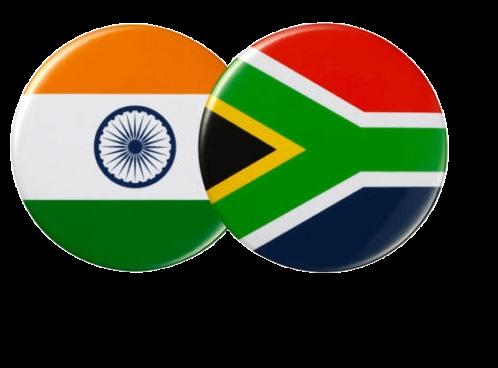
OPPORTUNITIES
The confidence that South Africa has displayed in filing a petition in the International Court of Justice (ICJ) against Israel for violating clauses of the Genocide Convention is an indication of its growing confidence in the international arena. On the other hand, India has played a much more muted role, considering its strong ties with Israel and the Arab nations. This move by South Africa, which is contrary to the views of the Western governments, could backfire in the long run, but for the present, it has been admired around the global South.
SECURITY AND TECHNOLOGY
Both India and South Africa come within the somewhat safe yet dangerous range on the Countries Safety Index. Security challenges in South Africa include high crime rates, armed insurgencies and social cleavages that directly relate to political corruption, and widespread unemployment and poverty. Governance deficits, political conflict and electoral violence also affect the consolidated democracy of South Africa. In addition, South Africa has witnessed a surge in cybersecurity challenges with increased threats of phishing and ransomware, data breaches and identity theft. The U.S.
Trade and Investment: In addition to existing trade and investment deals, India can engage in trade agreements exchanging Information Technology expertise for rare earth metals. This can help South Africa gain the technical knowledge to operate newer equipment, and India receives resources to produce clean technologies. India and South Africa’s opportunities in trade depend on the rate at which both are willing to uplift each other. India can offer to invest in South Africa to set up IT Companies where Indian experts can train South African locals, consult local businesses and widen the Indian perspective. South Africa can invest in energy sectors to help tap into more advanced infrastructure that poses significantly less harm to their environment. South Africa can also make the most of research and development achievements by trading intelligence through discussions with policy institutions, think tanks, academia, the military and NGOs. Both countries have a lot to offer and a lot to take, but what is exchanged depends on whether both decide to take up a Westernised style of trade and investment or seek out unique and mutually beneficial opportunities.
Social Systems: South Africa is facing failing energy systems, sky-rocketing crime rates and the worst economic disparity between black and white South Africans seen in all of Africa. Despite the decline in racially discriminatory activities in South Africa, it has taken a
37 STIRRING UP OF BLOOD TIES!

lot for the most oppressed communities to break free from the victim mindset and push for their rights and liberties. No matter what anyone says about freedom, the idea of being free begins with the mind. After centuries of being convinced that they are less deserving or valued than the fairer population, it will take a lot of generational healing, empathy building and narrative reframing for the worst victims to take up space in society and feel comfortable doing it. One major opportunity India and South Africa can work on is a cultural exchange programme.
The difference is that the setting in which Indians and South Africans interact will help appreciate their cultures’ similarities and differences without pitting them against each other. This can be through think tanks, schools and universities, NGOs, music, theatre and arts industries, large businesses and government-funded projects. With India interwoven into the population of South Africa, it is a great way to engage and get real perspectives and stories to deepen the relationship between people beyond the politicised and volatile context in this era.
Geopolitics: South Africa is Africa’s economic giant, with one-fifth of the continent’s GDP. However, holistic development depends on a country’s self-reliance; Russia’s negotiation to offer security in exchange for mining access for diamonds or China buying up major parts of Africa with negligible charges does not necessarily uplift the country’s individuality. It makes sense between Russia, China and the West why South Africa wants to look both ways and make the best out of what they all have to offer. India could become a friendly guide for South Africa to navigate its geopolitical routes in an increasingly unsettling and polarised world. It is a similar route that India has taken, and it could mean playing safe for as long as possible to avoid getting caught in the crossfire. One of the many things South Africa and India have in common, now more than ever, is challenging the Western world. South Africa’s case against Israel is the beginning of an uphill battle against Western dominance over international law and order. India contesting on the global stage as an economic superpower is another win for the Global South. Combining strengths, enhancing conversations on education, infrastructure and needs, and recalling common beliefs would be a
commendable move for the Global South to assert its opinions on Western double standards and strengthen its recognition as a force to be reckoned with.
Security and Technology: India can aid South Africa in navigating through the recent technological boom and the possible threats and vulnerabilities. India has had many trials and errors on the digital spectrum and can guide its partner. With the 2024 South African elections set in mid-May, technological awareness and security structures should be at an all-time high. Think tanks and non-profit organisations from India can help share insights and recognise new online threats like deepfakes, mass-malware attacks and scammers that could jeopardise diplomatic fairness and freedom in elections. Terrorism is a major security threat prevalent in both countries. By forming agreements and sharing security intelligence and technology to the extent that they abide by national interests, they can implement each other’s strengths to generate countermeasures before a problem arises.
KEY TAKEAWAYS:
South Africa represents Northern and Southern Africa, while India is seen as an informal representative of the Global South. Both countries are critical players in the Global South, and coming together would be an invaluable strategic power move. Beyond geopolitics, trade and investment, and technology, there is an underlying social struggle that threatens their relationship on a civilian level. India’s choosing to help South Africa begins with South Africans accepting help from Indians because apartheid made it seem like Indians took things away from them, too. There have been many instances where South African natives see the Indian diaspora as an unwanted community that holds significant power/influence in the country even today.
At a political level, shared Gandhian values of non-violence, mutual respect and unity helped South African leaders, like former president Nelson Mandela and even the current President Thabo Mbeki, lead the country through a peaceful transition. But how relevant these values are in the modern world is a mute question. The real opportunities like in tangible results in trade, investment and technologies.
38 STIRRING UP OF BLOOD TIES!

REACHING OUT TO AFRICA
India needs to frame its African strategy through an Indian lens.
Ancient history reveals Indian ties with East Africa over a thousand years before the foundations of Greece and Rome were built. A general fact agreed by many scientists and historians is that an early migration of Africans first settled in South India.
In the book ‘Afrocentrism: Myth or Science,’ Dr Clyde Winters writes that Ethiopians ruled much of India in antiquity. Called Nagas, they are the originator of Sanskrit. Dr Winters goes on to write that in the Bible and ancient Sanskrit literature, the old governmental structures of the so-called Africa-Middle East-Indian continent (though they were independent states) indicate a long and illustrious history linking Africa and the Indian-sub continent.
While Africans migrated, acclimated and naturalised to the Indian landscape and progressed, Indian migration to Africa was under an entirely different pretext. After the dawn of colonialism and a simmering influence of racial prejudices, Indians were taken to Africa as indentured labourers, especially in South Africa. There, they became accustomed to the discriminatory structure laid down by the coloniser government, making them a tier above the Black population because of white supremacy. The extent to which this hegemony has infiltrated the minds of people across the continents have ruptured the historical bonds between Africans and Indians. The former resent the latter for assuming a superior status, even to this date.


Jakkie Cilliers, Head of African Futures and Innovations at the Institute for Security Studies, believes India consistently underperforms diplomatically with Africa, and its interests in the continent are perfunctory. On the other hand, Africa is undeniably vulnerable to external shocks resulting from the structural deficits in its growth. The primary way for both to achieve a valuable long-term economic, geopolitical, social and security partnership is to become solutions rather than crutches for the other.
PRESENT CIRCUMSTANCE
India is on its way to becoming a leading global player, with predictions of becoming the third-largest economy by 2027. Africa is home to over half a dozen of the fastest-growing economies in the decade, like Rwanda, Senegal and Tanzania. Africa has enormous potential for foreign investments and partnerships, especially owing to rich natural resource reserves. However, late-blooming economies of Africa risk falling or have fallen into a “resource curse”, making them highly sensitive to major and minor changes in the global market. The continent has constantly been overlooked and ignored on global platforms, but a new interest in the AU has created a security relevance in emerging geopolitical dynamics.
TEAM
FOUNDATION GLOBAL SCAN
RESEARCH
SYNERGIA
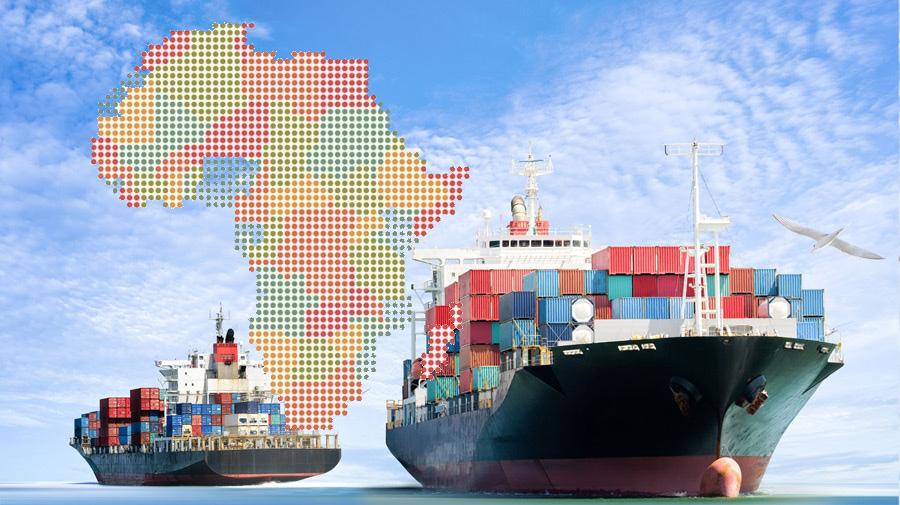
China has stood out as Africa’s largest economic partner since 2000 as an infrastructure developer, resource provider, and financier. They have made substantial investments in finances, materials, and diplomatic efforts. The U.S. has an ongoing Sub-Saharan African strategy to contest the growing Chinese influence over the continent. As former colonial powers of Africa, European nations are not too far behind. The German Chancellor visited Senegal, Nigeria and South Africa in 2022 to focus on investments, energy and food security. It seemed like a strategy to gain the African incentive over Russia’s diplomatic efforts. Yet, while all these superpowers nitpick at each other over Sub-Saharan Africa, they are not considering the centuries’ worth of values that African nationals do not align with.
CHALLENGES FOR INDIA
Times have changed, but the wounds remain the same. Despite India’s role in the anti-apartheid movement and aid to the freedom struggle, international relationships and partnerships have evolved beyond the simplicity of common cultural, historical and artefactual linkages. Present-day partnerships are strategy-focused as well as commonality finders. India wants the overall African Union’s geopolitical, economic, social, security, and technological development.
In saying this, Jakkie Cilliers, Head of African Futures and Innovations at the Institute for Security Studies, believes India consistently underperforms diplomatically with Africa, and its interests in the continent are perfunctory. On the other hand, Africa is undeniably vulnerable to external shocks resulting from the structural deficits in its growth. The primary way for both to achieve a valuable long-term economic, geopolitical, social and security partnership is to become solutions rather than crutches for the other.
India needs to frame its African strategy through an Indian lens. New Delhi needs to clarify three things before forming a substantial and mutually beneficial partnership between the two. The first is whether its African policy works through the government, private sector, or both. India’s private sector-led activity prioritises local productivity, transparency and skills that Africa needs. The second is what India can offer Africa aside from the sentimental historical linkages. The AU
may have fundamental differences with the West, but it is only a marginally significant upper hand for India. A sincere partnership that sets it apart from an opportunistic one will require India to uplift Africa’s economy, which heavily relies on its primary sector. Global commodity prices have started to improve, and Africa’s primary sector economy (agriculture and mining) is recovering. However, the secondary and tertiary sector economies have shrunk, hindering foreign investment opportunities and strategic growth in areas like trade, healthcare, hospitality, etc.
Unlike India, Africa’s low growth is structural, and there is a dearth of domestic investments within the Sub-Saharan region. Diversified economies with higher manufacturing value added to the GDP prove to make them more resilient in the event of global downturns. South Africa’s manufacturing value added as a percentage of its GDP is only 12 per cent as opposed to China’s, which is 32 per cent. Taking another comparison as an example, the Republic of Congo and Canada are both highly resource-dependent countries, but the latter’s growth has been different, and there is no need to imagine why. Technically speaking, the point of trouble is the Standard Operating Environment (SOE) in the AU. State involvement in activities determines how effectively actions are directed towards the economy, and corruption is one of the most prevalent issues that penetrate the AU system. A rise in populist spending, along with inherited inequalities, takes a stressful toll on how people’s mindsets perceive and persevere on an individual level, and this is still true on a national level. It creates a volatile environment, instigating the migration of skills and technical know-how the continent desperately needs for its economy.
The third point New Delhi needs to resolve is the optics of its soft power strategy in Africa. As the unofficial representative of the Global South, India has enforced a mode of aggressive diplomacy that boasts of its neutralistic approach to global issues. Despite pressures from its Western counterparts, the BRICS bloc (Brazil, Russia, India, China and South Africa) and the QUAD allies (the US, Japan, India and Australia), India has held a firm stance on its desires for multilateral representation and decisional sovereignty. There is much that both can benefit from and relate to each other. A strategy based on competitiveness and export promo-
40 REACHING OUT TO AFRICA
tion requires trade, finance, transport and energy ministers to come together and determine products and their competitive pros and cons. India has managed to look at its diplomatic relationships carefully and play a pivotal role in fostering regional cooperation, such as the International Solar Alliance that addresses energy security and greenhouse gas emissions, the “Neighbourhood First” initiative or the “Make In India” campaign which bolstered manufacturing capabilities, stimulating economic growth and creating jobs. On the other hand, Africa’s economic structural downshift relates to policy uncertainties, a lack of will to implement economic reforms, poor governance of their security operations centres (SOCs), government debt and fiscal spending, social pressures and civil unrest, and concerns over the affordability of the nuclear programme.
OPPORTUNITIES
The African continent of nations indicates a plethora of opportunities for collaboration with India. The real GDP in Africa and Sub-Saharan Africa has doubled in the past decade since the 1980s-’90s. In 2022, India finally achieved a positive trade balance with Africa, and the latter is an untapped market for manufacturing goods such as textiles, pharmaceuticals, automobiles, high technology, etc.
Africa is rich in crude oil, gas, gold, leather, metals, pulses and lentils. Namibia and Niger are rich in Uranium, and South Africa for Platinum and Chromium. Africa can also aid globally in manufacturing goods in high technology with the help of Indian partnerships that can provide them with the skill and know-how. For example, the Libyan economy is invariably linked to the oil sector, and any change in global demand upheaves its economy. Resource-dependent nations, like Libya, can be helped to diversify their economies by focusing on manufacturing added value. It is not simply about exporting rare materials; Africa can benefit from Indian businesses investing in the economy and setting up local manufacturing sectors to harness the active diaspora as one that contributes through its present strategies.
India is persistent in fostering robust developmental partnerships. They have helped promote the Pacific Island Nations’ financing capacities by consistently highlighting developing countries’ concerns at conferences like the Forum for India-Pacific Islands Cooperation Summit (FIPIC). At the most recent G20 summit, India boldly suggested including the African Union in the group of twenty, which is now official. This matters to a successful and seamless green energy transition as its impacts on Africa are multifaceted.
The decrease in demand for oil and fossil fuels will rattle economies like Libya. However, the demand for cobalt, manganese, chromium, nickel and other rare earth elements will increase. The Democratic Republic of Congo dominates the current production of Cobalt, while Zambia is one of the handful of nations that hold its reserves. The ongoing and increasing demand for rare earth elements, essential in manufacturing green energy technologies, has even led Norway to consider
opening its water to privates for deep-sea mining. African countries can seize this opportunity to expand from their primary sectors and diversify their economies.
According to the Assistant U.S. Trade Representative for African Affairs, Florie Liser, an increase in trade of African goods from 2 per cent to 3 would generate USD 70 Billion of additional income for Africa, three times the total development assistance Africa gets from the world. India has become significant in the picture in fostering regional relations, enhancing trade and economic resilience, and diversifying towards inclusive growth between the two and among the African subcontinent nations.
Rich countries of Africa like South Africa, Nigeria and Rwanda have extensive infrastructure and large, sophisticated business sectors with high-payment systems and academic and research institutes, like India. However, these sectors are not in sync with trade or development when they should be. Think tanks, academicians, high-level interactions, and policy discussions between the two can help Africa gain perspectives on strategies to diversify its economy, maintain fiscal and policy continuity, and benefit from the technological advantages of India’s being an IT hub.
CONCLUSION
India’s rise as a global power will be linked to a successful relationship with Africa. As a nation that has also borne the horrific truths of colonisation, India has an undeniable urge to contribute to the sustainable development of the Global South and strengthen its strategic connections with Africa, which has been identified as the next big “frontier” by the West. India does not see Africa as a frontier, sitting at the periphery of development, but has foresight into the bigger game within which it plays an unfortunate pawn. While addressing the drawbacks of initial partnership attempts, India and the Sub-Saharan countries can come together, not as two perceived outliers, but as realised power cards in the global economy.
KEY TAKEAWAYS:
Recasting radical economic transformation into workable programmes to get the African society moving is crucial in ensuring Africa does not succumb to the “resource curse”. Africa and India have a tangible understanding of each other. However, efforts to maintain that understanding have fallen short on an economic and geopolitical level.
As the world contests Africa’s attention in geopolitical play, India needs to step up and help the AU refocus on the most important matter and its biggest flaw - sustainable and inclusive development.
India’s rise as a global power will be linked to a successful relationship with Africa, and the primary focus for India could be to partner with Africa to diversify its economy from a primary-sector dependent to a multi-sector economy.
41 REACHING OUT TO AFRICA

TAIWAN ELECTIONS: TAKING A COUNT


An emboldened Lai Ching-te asserts Taiwanese sovereignty but remains short of claiming a formal declaration of independence.

Lt Gen G A V Reddy AVSM, SC, VSM (Retd) is the former Deputy Chief of Integrated Defense Staff, DG-DIA and Strategic Advisor at Synergia Foundation.
The Taiwanese presidential election was held on January 13, 2024, as part of the general elections. The election results were largely in line with public opinion polls, which consistently showed Lai Ching-te leading his opponents.
Currently, Vice President, Lai ultimately won the election with just over 40 per cent of the vote. The Kuomintang (KMT) candidate Hou Yu-yi placed second with 33.5 per cent, and Taiwan People’s Party (TPP) candidate Ko Wen-je received 26.5 per cent of the vote. The Democratic Progressive Party (DPP) presidential candidate won, but the party lost its majority in the legislature. The TPP’s popularity among young people was clear, with Ko’s 4 million votes coming mainly from Tsai’s. The election was held amid significant pressure from Beijing, and Taiwan continues to stand out in Asia as a vibrant, prosperous, and stable democracy.
CROSS-STRAIT RELATIONS AND NATIONAL DEFENCE
Xi Jinping has asserted his power in China, having secured an unprecedented third term as General Secretary of the Chinese Communist Party, the most powerful position in China. The 2022 Russian invasion of Ukraine also prompted fears of an escalation between Mainland China and Taiwan. The CIA is
The election outcome will chart the trajectory of Taiwan’s relations with China over the coming years, as Lai Ching-te has steered the island toward democracy and away from China. This will require Beijing to reconsider its approach to cross-strait ties.
on record warning not to take lightly Chinese potential for a cross-channel invasion. In April 2022, after then-President Tsai Ing-wen visited the U.S. and met House Speaker Kevin McCarthy, the Chinese military responded with military exercises near Taiwan. Lai has asserted Taiwanese sovereignty but said a formal declaration of independence would be unnecessary. He also said he would be willing to work with the Chinese government, but only if they renounce any intentions to use force against Taiwan. In November 2023, Lai argued that closer economic ties with like-minded countries could maintain Taiwan’s sovereignty while preventing conflict escalation.
The DPP favoured a continuation of the status quo of cross-strait relations, coupled with strengthening ties with the U.S. Lai did not rule out dialogue with China but described Taiwanese sovereignty as ‘a fact’.
Apparently, there were attempts by China to influence the Polls as Taiwan arrested hundreds of people under the Anti-Infiltration Act, some of them having received money from China. China allegedly paid Tai-
GEOPOLITICS

wanese soldiers to make surrender videos. Taiwanese intelligence reported that China coordinated a disinformation campaign on social media to influence the election, and these efforts were meant to drive a wedge between Taiwan and the U.S., portraying the latter as unreliable regarding the defence of Taiwan. Most sources of disinformation were credited to Taiwanese groups favourable to China.
INTERNATIONAL REACTION
China said that regardless of the election result, the basic fact that there is only one China in the world and Taiwan is part of China will not change. In response, Taiwan urged Beijing to fully respect the election results and Taiwan’s public opinion. The PRC objected to Japan, the U.S., Singapore and the Philippines congratulating Lai and warning them against interfering in China’s internal affairs.
During election day, Taiwan’s Defence Ministry detected eight Chinese military aircraft and six naval vessels. On 14 January, four Chinese military vessels and a high-altitude balloon were detected around Taiwan. Taiwan alleged that China encouraged Nauru to shift diplomatic recognition from Taiwan to China, coerced ASEAN countries to echo the fictitious narrative of the so-called ‘one China principle and instigated statements made by the Solomon Islands, the Maldives, and Bangladesh which disparaged Taiwan’s sovereignty status.
U. S. President Joe Biden reiterated that the U.S. does not support Taiwanese independence. The U.S. officially acknowledges the PRC’s claim to Taiwan but remains a staunch supporter of the status quo: a self-governed, fully democratic society with its own economy, currency, military, and elected officials. President Biden has also said the U.S. would come to the defence of Taiwan if attacked, seemingly abandoning the U.S.’s long-maintained “strategic ambiguity” on Taiwan, and has stepped up military exercises with allies across the Indo-Pacific.
Russia said that it would continue to recognize Taiwan as an integral part of China, and any attempt by any country to use the election to pressure China is counterproductive and should be condemned by the international community.
The European Union statement said it welcomed Taiwan’s presidential election, expressed concern about growing tensions in the Taiwan Strait and opposes any unilateral attempt to change the status- quo.
PRC DILEMMA OVER TAIWAN
China expected Lai’s victory and prepared contingencies for political, economic and military options to deal with Lai if the PRC felt his actions were provocative. China is likely to scale up military air and maritime activity near/within Taiwan’s ADIZ and continue with grey zone warfare tactics to pressure Taiwan. The possibility that Beijing could use significant military force against Taiwan in 2024 if the PRC views Lai as crossing a critical redline cannot be ruled out.
China recognizes that Lai did not win over 50 per cent of the presidential vote and the DPP did not maintain a majority in the Legislative Yuan. This provides Beijing with breathing space and allows China to continue to argue that peaceful unification is still possible and Lai does not represent the will of the Taiwanese people.
China faces significant economic headwinds domestically, and a military option against Taiwan could weigh on foreign investment and cause multinational companies operating in China to reduce their activities and footprint.
Beijing has actively sought to stabilise U.S.-China relations, but military operations against Taiwan could undermine the U.S.-China bilateral ties.
Xi Jinping is aware that the PLA suffers from internal problems. The purging of senior PLA leaders and
43 TAIWAN ELECTIONS: TAKING A COUNT

focus on rooting out problems within China’s military will likely cause Xi to think twice about using significant military force.
IMPLICATIONS OF POLLS
The 2024 Taiwanese presidential election had several implications for Taiwan’s domestic politics. The election resulted in the Democratic Progressive Party (DPP) winning an unprecedented third consecutive term, reflecting the preference for the status quo and continuity of national policies. Additionally, the election marked the first time since 2004 that no single party commanded a majority in the Legislative Yuan, with legislative power being split among three political parties: the DPP, the Kuomintang (KMT), and the Taiwan People’s Party (TPP). The rise of the TPP demonstrated its potential as a significant political force, although its long-term viability remains in question.
The election also highlighted the need for the incoming president to navigate the new power dynamics in the post-2024 elections political landscape. The hung parliament will make governance more challenging for the DPP, testing the new president’s political skills. The election results have led to significant shifts in Taiwan’s politics, with critical implications for the country’s future governance and policy direction. The election outcome will chart the trajectory of Taiwan’s relations with China over the coming years, as Lai Ching-te has steered the island toward democracy and away from China. This will require Beijing to reconsider its approach to cross-strait ties, as Lai’s victory will impact the management of heightened tensions with China. The election results will have significant implications for Taiwan’s domestic politics, as the incoming president must navigate an increasingly complex relationship with Beijing and the new power dynamics in the post-2024 elections political landscape.
Xi Jinping has taken a hard line on cross-strait relations; thus, the implications for the U.S.-China-Taiwan triangle in 2024 and beyond is a matter of concern, as the U.S. has a significant interest in maintaining peace and stability in the Taiwan Strait as also expanding geo-strategic interest in Indo– Pacific while preventing Chinese further influence in the region.
INDIAN INTEREST IN TAIWAN
Taiwan holds strategic relevance to India due to several factors. India and Taiwan share strategic interests in the Indo-Pacific region. The economic interest in preserving peace and stability in the Taiwan Strait is evident from the bilateral trade between India and Taiwan, which is estimated to be worth over $7 billion.
Taiwanese firms have also invested over $2.3 billion in India. The dependence of Indian industries on IT, Semiconductors and electronics is huge. The disruptions in supply chains will obviously adversely impact the Indian economy. The trade flowing through the Taiwan Strait will only add to the risk to the Indian economy.
India and Taiwan have growing cooperation in science and technology, with over 80 joint projects carried out before the pandemic and almost 3,000 Indians now studying in Taiwan. Taiwan also provides a window into the People’s Republic of China (PRC) for India, which is significant given the worsening of India-China relations in the last decade.
PROGNOSIS
China has long described reunification with Taiwan as a goal. However, Beijing knows that using military force would likely result in the developed world inflicting negative economic consequences in response. China is much more integrated with the global economy compared with Russia before attacking Ukraine.
The threat of sanctions from the rest of the world could cause significant damage to China’s economy. The election outcome may not hold much significance for Taiwan’s immediate future. Taiwanese, for the time being, are in favour of the status quo rather than a shift to either independence or reunification. The real challenge is to preserve Taiwan’s technological gains and economic development in the face of the dynamic geo-political flux of the region.
KEY ISSUES
• Accommodating the PRC no longer resonates in Taiwan, with local identity urges prominent now. Youth fear Hong Kong-like crackdown by the PRC and the bleak future for them if they unified with China.
• Lai Ching-te prefers the continuation of the status- quo and is mindful of the need to tread cautiously with the PRC while strengthening ties with the U.S.
• Xi Jinping is averse to enormous economic sanctions resulting from any military action against Taiwan despite a likely rise in tensions. KMT still holds hopes for the PRC; Xi Jinping would rather wait for KMT gains to be further consolidated over the years.
• Taiwan is a status quo in U.S.-China relations, both focussing on their own economic growth and geo-strategic interests.
44 TAIWAN ELECTIONS: TAKING A COUNT

TURNING RED


The Red Sea has become an arena of conflict between David and Goliath with international repercussions.
SYNERGIA FOUNDATION
The Red Sea holds immense strategic importance as a key maritime passage where ongoing regional tensions frequently play out. Its critical role spans economic, military, and security spheres, rendering it one of the world’s vital international waterways. Consequently, any conflict in this region harbours the potential to escalate into a broader conflict, endangering global peace and stability.
POLITICS OF GEOGRAPHY
The Bab-el-Mandeb Strait is a crucial chokepoint for maritime traffic entering and exiting the Red Sea for nearly 30 per cent of global container shipping and 15 per cent of global trade, mostly bound for Asia.
Despite being the poorest country in the region, Yemen holds a crucial position on the eastern side of the Bab-el-Mandeb Strait, often referred to as “the Gate of Grief.” This 16-mile stretch of water serves as the entrance to the Red Sea, a vital global shipping lane. The Red Sea ranks as the second most significant maritime route, trailing only the English Channel and standing third among the Panama Canal, Danish Straits, and the Strait of Malacca, which is the fourth and fifth busiest routes, respectively. While widely acknowledged for its strategic importance, the geopolitical complexities surrounding the Red Sea exacerbate the precarious nature of this chokepoint.
Economists warn that persistent attacks in the area could erode global trade dynamics. While the immedi-
India finds itself delicately navigating diplomatic complexities while playing a pivotal role in the Red Sea, where it has maintained the region’s most extensive naval presence since 2008—surpassing the U.S., France, and China. Instead of focusing on countering the Houthi threat in the Red Sea, the Indian navy has directed its efforts toward combating piracy in the Gulf of Aden and the Arabian Sea.
ate repercussions might not be immediately apparent, the cumulative impact could lead to prolonged uncertainty for shipping companies. This scenario could precipitate a global economic upheaval akin to the disruptions witnessed during the onset of the Covid-19 pandemic.
A surge of missile, drone, and hijacking attacks targeting civilian ships in the Red Sea, over the past two months, has led to the most significant disruption of international trade in decades. Egyptian President Abdel Fattah al-Sisi has claimed that Egyptian earnings through transit rights of the Suez Canal have dipped by as much as 50 per cent since the Houthis launched their campaign against commercial shipping in the Red Sea. This escalation has increased shippers’ costs, impacting regions as distant as Asia and North America.
Despite multiple retaliatory strikes by the U.S. and its allies and a multinational naval operation to patrol the waters, the assaults by Houthi militants persist.
RESEARCH TEAM GEOPOLITICS
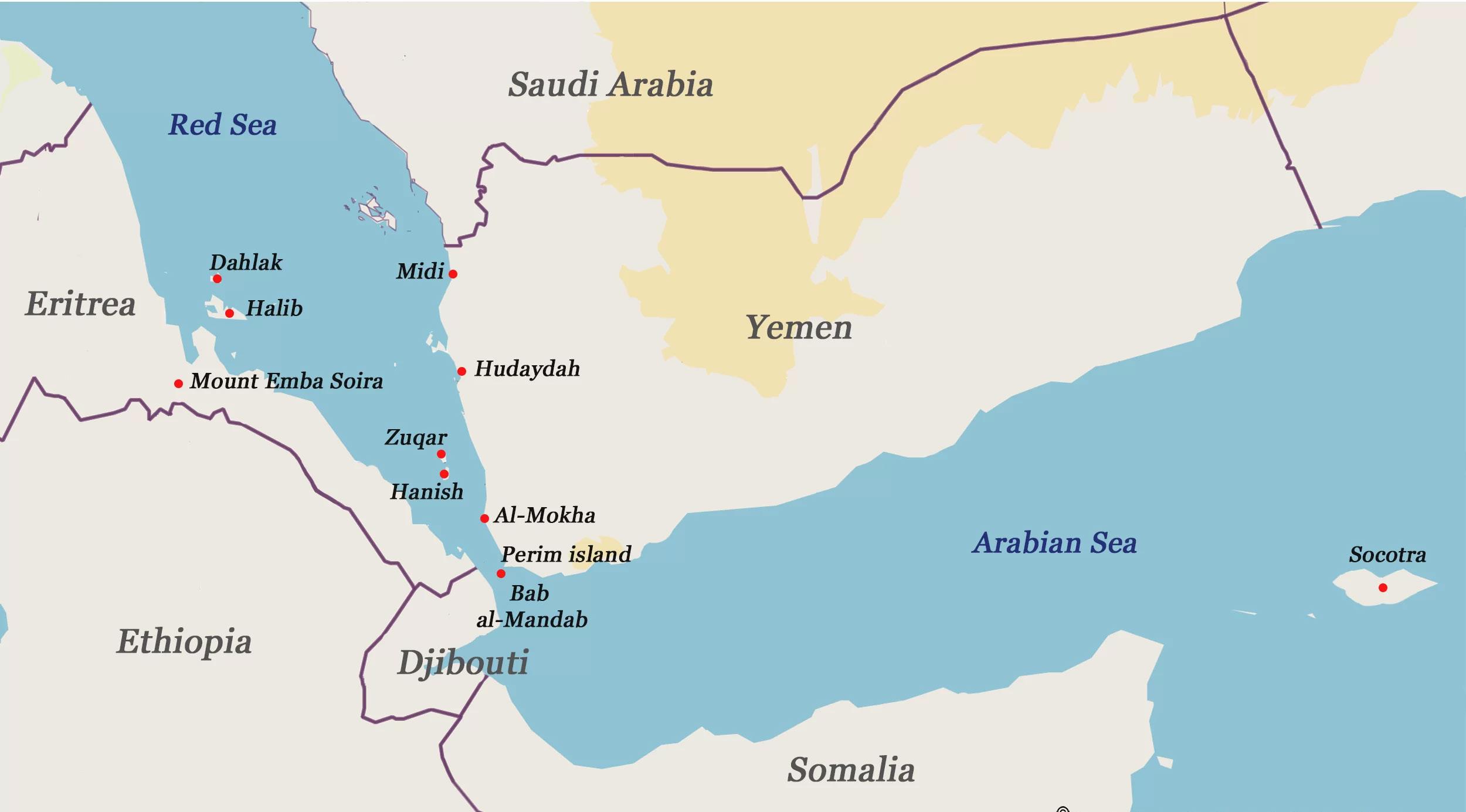
PROXY TERROR VERSUS GLOBAL ECONOMY
Financed and supported by the theocratic dictatorship in Tehran, the Houthis have targeted commercial ships navigating the Bab-el-Mandeb Strait since November 2023. Impoverished after years of destructive conflict and propped up by their external benefactors, the Houthis themselves have little stake in global trade. They are immensely enjoying putting the ‘haves’ of the world to acute discomfort.
Their indiscriminate attacks, justified by the Houthis as targeting vessels associated with Israel in response to the Israel-Hamas conflict, have prompted shipping giants like Maersk and Hapag-Lloyd to suspend services through the Red Sea. Rerouting ships around the Cape of Good Hope incurs an additional $1 million worth of fuel cost per trip.
This crisis represents the most severe supply chain disruption since the COVID-19 pandemic, endangering the global economic recovery and potentially leading to inflation due to rising freight and oil prices. The seizure of the cargo ship Rawabi by the Houthis intensifies the complexity of the situation, marking a departure from historical incidents in the Red Sea linked primarily to Somali-based piracy.
The uncertainty surrounding the fate of the Rawabi and the silence surrounding the incident deepens concerns over maritime security and regional stability. The heightened tensions between the Houthis, Israel, and Iran, along with potential impacts on efforts to resolve the Yemen conflict, pose significant challenges. The fear of broader conflict involvement, particularly with Israel retaliating against the Houthis, could escalate violence in the Middle East.
In response, the U.S. has initiated an international naval operation, joined by the UK, Canada, France, Bahrain, Norway, Spain, and others, to protect ships in the Red Sea route. Despite these security measures, many shipping companies hesitate to resume trade, indicat-
ing a prolonged disruption. While higher costs have not yet translated into inflation, central bankers, including Christine Lagarde of the European Central Bank, warn of potential risks, particularly from supply bottlenecks and a spike in oil prices due to the conflict.
Since January 12, the United States and Britain have conducted strikes against Houthi targets within Yemen, inflicting damage to drone/ missile launch sites. But the attacks persist. This has transformed the geopolitical climate in and around the Red Sea from tension to a complex dispute and, currently, to a low-intensity conflict.
COMING TOGETHER OF A NEXUS
The military conflicts in the Red Sea can be seen as an extension of the Israel-Hamas dispute, involving both state and non-state actors in the region and transcending national borders. Serving as a proxy for Iran, the Houthi group, strategically positioned in the southeastern Arabian Peninsula, effectively targets international shipping. Similarly, Hezbollah, considered another Iranian proxy in Lebanon, poses a threat to Israel’s security from the north, leveraging Lebanon as a base of operations.
Hezbollah is not merely a proxy but a formidable military force, strategically utilising Lebanon and engaging in aggressive actions such as launching rockets, employing anti-tank missiles, and executing strikes on military targets using explosive drones. Iran has warned of the Mediterranean Sea becoming a conflict zone if the U.S. and Israel persist in what it deems as crimes against humanity in Gaza. While Iran denies involvement in the Red Sea attacks, Houthi strikes have become more indiscriminate, involving multiple assaults on commercial shipping through anti-ship missiles, drones, and attack craft.
Additionally, with Europe discontinuing oil purchases from Moscow due to the Ukraine invasion, the Red Sea route has become crucial for Russian oil cargoes. Despite Houthi assurances, two ships have been
46 TURNING RED
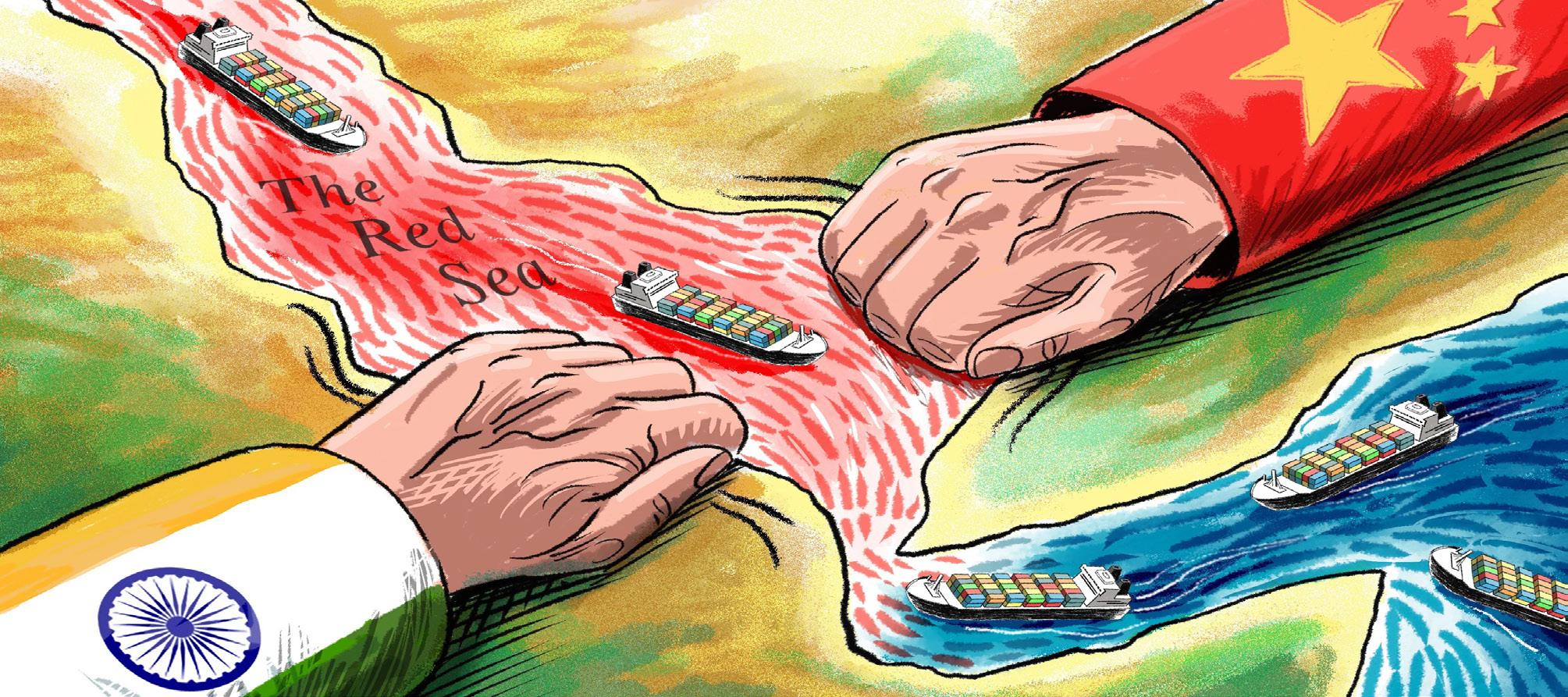
accidentally struck. Other oil producers are utilising this route to avoid potential Houthi attacks. Most Middle East crude for the U.S. Gulf Coast already takes the longer route around the Cape of Good Hope due to size constraints in the Suez Canal.
INDIA’S DIPLOMATIC TIGHTROPE
Indian Navy assets are currently in the middle of the largest deployment in the Gulf of Aden and Western Arabian Sea. The Government of India has taken great pains to clarify that this deployment is not part of the U.S.-led military action against the Houthis. A spate of piracy-related attacks has come as a surprise in the Gulf of Aden, possibly taking a cue from the Red Sea confusion after a gap of nearly six years.
India has opted to maintain a diplomatic balance with Iran, refraining from participating in the task force due to longstanding and robust bilateral ties. India finds itself delicately navigating diplomatic complexities while playing a pivotal role in the Red Sea, where it has maintained the region’s most extensive naval presence since 2008—surpassing the U.S., France, and China. Instead of focusing on countering the Houthi threat in the Red Sea, the Indian Navy has directed its efforts toward combating piracy in the Gulf of Aden and the Arabian Sea. This involves deploying guided missile cruisers, marine patrol aircraft, and drones to monitor commercial shipping in these areas.
The recent surge in attacks has significantly impacted India’s trade and exports, and it is heavily reliant on the Red Sea and Egypt’s Suez Canal for safe passage. Serving as a gateway to key regions such as Europe, North America, North Africa, and West Asia, the disruptions have led to substantial delays in shipping exports for India.
Threats to cargo vessels, a spike in container shipping rates, and exporters withholding shipments through the Red Sea are among the challenges. Estimates from a New Delhi-based think tank suggest that these delays could potentially reduce India’s total exports, valued at $200 billion, by around 20 per cent. While India has not formally joined the U.S.-led task force, it responded to
a drone attack on a crude oil tanker heading to India by deploying two guided missile destroyers and a Poseidon maritime surveillance aircraft in the Arabian Sea. Speaking to the media on Feb 19th, the Chief of Naval Staff acknowledged that the Indian Navy was conducting anti-drone operations in the North Arabian Sea and Red Sea. This underscores India’s commitment to safeguarding its maritime interests and responding to threats to its vital trade routes.
PATHWAY TO A WIDER CONFLICT?
Approaching its 100th day, the ongoing conflict in Gaza is underscored by Houthi attacks on vessels in the Red Sea, emphasising the complexity of the situation and the imperative to contain and prevent further escalation. The regional political landscape and current security conditions significantly shape the broader consequences of the Israel-Hamas conflict and Israel’s military actions in Gaza. These dynamics reveal the challenges of mobilising Western and international responses, the risks of unilateral actions, and the limitations in resolving the escalating situation.
The U.S. grapples with a challenging position as a security provider closely aligned with Israel, exhibiting reluctance in dealing directly with the Houthis to avoid triggering further escalation. Despite assembling a multinational naval coalition to protect shipping in the Red Sea, recent actions, including the killing of Houthi boat crew members, signal a shift in approach. The U.K. expresses readiness for further action if Houthi attacks persist. At the same time, Iran’s support for the Houthis and the deployment of an Iranian destroyer into the Red Sea adds another layer of complexity.
However, the U.S. faces constraints due to Saudi Arabia’s concerns about the impact on peace efforts in Yemen and fears of bolstering Iranian influence in the region. The attacks on Houthi vessels, while a departure from previous practices, fall short of decisive strikes on militant bases within Yemen. The Houthis remain undeterred, stating their intention to continue harassing shipping unless specific conditions, such as allowing humanitarian aid into Gaza and halting Israeli attacks, are met.
47 TURNING RED

BUDGETING FOR GROWTH


India’s interim budget has laid out the roadmap for growth by signalling an investment boost, tax relief and key measures for focus groups. RESEARCH
Amid persistent global economic uncertainty, the Indian economy has stood as a robust performer, poised to leverage the numerous economic opportunities in the upcoming years. The GDP growth continues to exhibit strength, maintaining a solid 7 per cent in FY 2023 and is anticipated to persist above 6 per cent in FY 2024.
Against this backdrop, it is unsurprising that the budget prioritises continuity and stability across various aspects, with a particular emphasis on taxation.
BUDGETARY PROVISIONS
The budget has chartered out the government’s economic agenda as centred on three key aspects: firstly, providing opportunities to citizens; secondly, fostering robust growth and job creation; and finally, reinforcing macro-economic stability.
The budget outlines various priority areas, with a particular focus on agriculture and infrastructure. Notable efforts include the development of digital public infrastructure in agriculture, the strengthening of credit for farmers, and the promotion of the cooperative sector. Infrastructure development is viewed as a significant driver of growth and employment, evidenced by a record 33 per cent increase in capital outlays this year, reaching INR 10 lakh crore. The budget empha-
A shift from agriculture to manufacturing, coupled with an increased demand for the Food for Work programme, reflects notable changes in the economy. Finance Minister Nirmala Sitharaman implemented a 3.3 per cent reduction in the food subsidy to 2.12 trillion rupees ($25.5bn) for the fiscal year 2025, down from 2.05 trillion rupees ($24.6bn) in the current fiscal year.
sises enhancing private investment in this sector, with considerable capital allocations for railways.
The budget also addresses policy interventions for Medium, Small, and Micro Enterprises (MSMEs), offering increased funding for credit guarantees and proposing the return of 95 per cent of forfeited sums due to non-execution of contracts by MSMEs. A scheme for settling contractual disputes with graded settlement terms is also outlined.
India’s commitment to green growth and achieving net-zero carbon emissions by 2070 is reiterated in the budget. Measures include increased funding for energy transition and promoting energy-efficient coastal shipping. The government plans a comprehensive review of financial sector regulations to simplify compliance. Policy changes for the International Financial Services Centre (IFSC) framework involves a single window
ECONOMICS
TEAM SYNERGIA FOUNDATION
clearance system, recognising offshore derivative instruments, enabling acquisition financing and establishing data embassies.On the direct tax front, the budget continues to focus on easing compliance, widening the tax base, and rationalising various provisions.
Changes in the tax regime for individuals introduced 2020, aim to make it more attractive for taxpayers, including adjustments in slab rates, rebates, and surcharges. Anti-abuse provisions targeting companies raising capital at high premiums have been expanded to cover investments by non-residents, potentially impacting foreign inflows into India.
Despite global trends moving towards implementing Global Minimum Tax Rules (GloBE), the budget did not provide guidance on India’s adoption of these rules or announce a detailed public consultation process.
AN ECONOMY IN CHANGE
A shift from agriculture to manufacturing, coupled with an increased demand for the Food for Work programme, reflects notable changes in the economy.
Finance Minister Nirmala Sitharaman implement ed a 3.3 per cent reduction in the food subsidy to 2.12 trillion rupees ($25.5bn) for the fiscal year 2025, down from 2.05 trillion rupees ($24.6bn) in the current fis cal year. The fertiliser subsidy was also trimmed, while capital expen diture remained at 1.3 trillion rupees ($15.6bn).
By controlling such expenditures, Sitharaman announced a fiscal deficit of 5.1 per cent for the year ending March 2025, surpassing market expectations of around 5.3 to 5.4 per cent.
Nirmala Sitharaman also unveiled initiatives to empower women through skill-building and entrepreneurship, expanding schemes to train rural women in skills like bulb-making and plumbing. This move aims to transition women from largely agricultural employment with low wages to manufacturing jobs, contributing to greater workforce diversity.
The finance minister’s announcements also addressed environmental concerns, with a household rooftop solar energy scheme for 10 million households, allowing them to claim 300 units of free energy monthly. These households can also sell surplus energy. Additionally, there are plans to expand the charging infrastructure for electric vehicles and provide a viability gap funding for wind power projects, aligning with India’s commitment to achieving net-zero emissions by 2070.
OPTIMISTIC BUT INDIFFERENT?
Criticism of the budget has centred on areas that the finance minister did not directly address, particularly the ongoing job creation crisis. The Union budget speech outlined seven key priority goals for the fiscal outlay map, including inclusive development, last-mile development, infrastructure and investment, green growth, youth, and the financial sector.

This subsidy reduction signifies India’s strategic shift “away from agriculture towards manufacturing,” according to Suman Bannerjee, Chief Investment Officer at Hedonova, a global hedge fund.
The government had previously pledged free food supplies to India’s poorest, safeguarding them from potential food price hikes. Nirmala Sitharaman highlighted in her speech that average real income has risen by 50 per cent, lifting over 250 million people out of poverty and propelling the economy from the 10th to the world’s fifth-largest in the last decade.
To bolster the rural economy, the finance minister introduced various schemes, including those for rural housing, free food for the impoverished, and the enhancement of aquaculture. Despite India’s robust economic growth projection of 7.3 per cent for the year ending March 2024, concerns persist about its urban-centric focus. The recent budget measures aim to extend the benefits of urban growth to invigorate the rural economy, indirectly transferring income and ensuring growth reaches rural areas.
However, when reviewing the key announcements, the overall impression is that it is a ‘no-gain-no-pain’ budget. It overlooks previous shortcomings in job creation and fails to address concerns about India’s poor social spending landscape and the developmental priorities of the
Regarding government capital expenditure (capex), the budget allocates approximately Rs 10 trillion for longer-term capital expenditure in 2023-24, surpassing the Rs 7.5 trillion budgeted for the previous year and marking the highest on record.
Critics argue that the government’s capex drive has not yielded significant dividends in terms of driving overall macro-growth or encouraging private investment opportunities. Despite a robust 10.4 per cent second-quarter FY23 growth in real Gross Fixed Capital Formation (GFCF), recent data indicates a contraction in real fixed assets of non-finance and manufacturing companies.
While an increased government capex outlay may be welcomed in the short term, sceptics warn it may do little to change the underlying circumstances for overall investment. Private firms are reluctant to invest more or in new capacity at 75 per cent private sector capacity utilisation remain largely unaffected by various fiscal incentives, including corporate tax cuts, PLI schemes, and increased government capex.
The current budget fails to focus on creating employment opportunities for the youth or driving pri-
49 BUDGETING FOR GROWTH
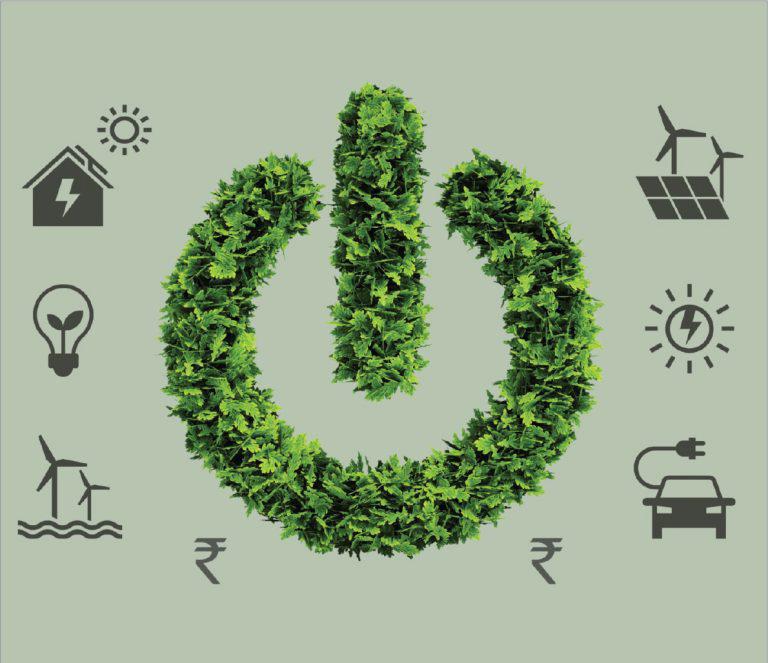
vate investment, while social welfare scheme spending remains minimal. The absence of targeted job creation allocations and the oversight of an urban version of the MGNREGA program has disappointed critics.
The meagre allocation of Rs 60,000 crore for MGNREGA, the lowest in comparison to previous years during this term of the Modi government, adds to the disappointment. As a result, the budget is anticipated to continue on the same path until the 2024 Lok Sabha Elections.
KEY TAKEAWAYS
The budget outlines key priorities across various domains:
Fiscal Discipline: The revised estimates reaffirm the commitment to achieving the targeted 6.4 per cent of GDP. This move is expected to enhance India’s global competitiveness and boost exports. Additionally, there is a progressive shift towards result-based budgeting on a pilot basis.
Capex Boost to Economy: A significant 33 per cent increase in capital expenditure (capex) allocation, amounting to INR 10tn, is aimed at stimulating economic growth. Notably, the substantial INR 2.4tn allocation to railways is seen as positive, given the absorptive capacity of the road and railway sectors.
Consumption Boost: The budget aligns announcements on personal income tax with incentives to encourage taxpayers to transition to the new tax regime. This includes enhancements to tax slabs and reductions in rates.
Lower taxes in the new interest regime are anticipated to lead to higher disposable incomes, supporting consumption. A 66 per cent increase in allocation to the PM Awas Yojana is expected to generate jobs in rural areas, further supporting consumption.
Atmanirbhar: Responding to previous criticism, the budget lowers customs duties on components and items used for manufacturing. This signals a shift towards India actively participating in the global value
chain, making it attractive to multinational companies reconsidering their manufacturing and supply chains.
Reaping the Demographic Dividend: The budget emphasises youth-focused initiatives, termed ‘Amrit Peedhi,’ focusing on skills development, apprenticeships, and schemes to tap into the demographic dividend until 2047.
Supporting MSMEs: Several announcements support Micro, Small, and Medium Enterprises (MSMEs), including continuing the Credit Guarantee Line with an additional allocation of INR 90bn. Support for artisans, micro-enterprises, unity malls under the One District One Product Scheme, and initiatives to help MSMEs access markets have also been highlighted.
Ease of Doing Business: Measures to enhance the ease of doing business include a one-stop solution for ID and address updates using Digilocker and Aadhar, PAN as the common business identifier, and a unified filing process across different agencies.
Sustainable and Inclusive Growth: Green growth-related initiatives are introduced, such as allocating INR 350bn for energy transition and PPP-based battery energy storage systems. A green credit program incentivising environmentally sustainable actions aligns with the LiFE philosophy promoted by the Prime Minister.
Additionally, announcements support cooperatives, farmers, disadvantaged communities, and the promotion of millets (‘Shree Anna’) for inclusive development.
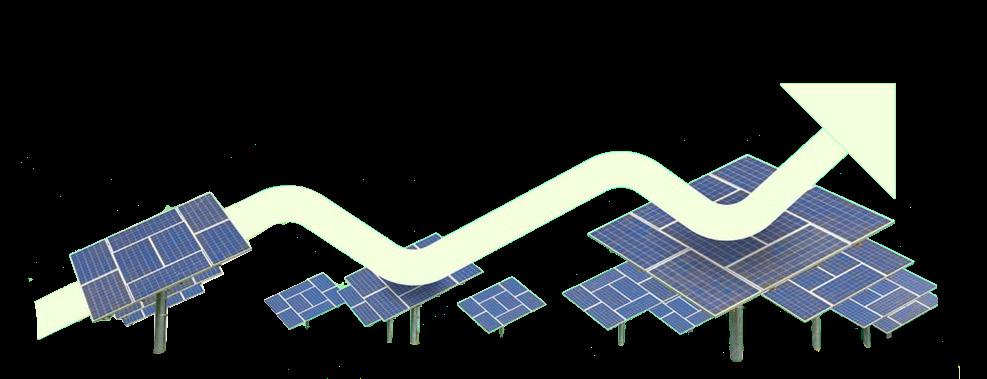
Assessment
The interim budget appears to have laid the road map for the government’s development plan. The seven key priority goals for the fiscal outlay map, including inclusive development, last mile development, infrastructure and investment, green growth, youth, and the financial sector, provide a robust platform.
The central criticism of this budget has been that it neglects past deficiencies in job creation and does not tackle concerns regarding India’s inadequate social spending framework and the developmental needs of the younger population. The budget has been criticised for a lack of emphasis on generating employment opportunities for the youth or stimulating private investment.
50 BUDGETING FOR GROWTH



QUAD: TRANSFORMING GLOBAL HEALTH
The multifaceted dimensions of Quad are highlighted by its efforts to transform global health by overcoming paradoxes and embracing innovations.
SYNERGIA FOUNDATION
The Quad framework has evolved beyond its initial strategic focus to become a crucial force in addressing global health challenges. Particularly in the aftermath of the COVID-19 pandemic, the health sector within the Quad framework has emerged as a focal point of cooperation.
The exploration delves into the paradoxes faced in global health governance and the innovative strides taken within the Quad to overcome them.
The Quad framework aggressively delved into the health domain during the pandemic to match the efforts of China. By 2021, China had promised one billion doses of its home-grown vaccine to Africa and about 150 million to ASEAN countries. This prompted Quad to match China’s soft power approach with its own vaccine initiative, which offered nearly 1.2 billion doses to the Indo-Pacific by the end of 2022. The U.S. Development Finance Corporation loaned $ 50 million to the Indian pharma company Biological E for this purpose.
In addition, J&J’s single-shot vaccines were also procured. However, the Quad vaccine distribution stalled as the pandemic subsided, and vaccine hesitancy was rising. Ultimately, only India donated under the Quad umbrella, while the other three members donated bilaterally.
Collaboration with Quad countries holds tremendous potential for India’s pharmaceutical industry, which currently contributes significantly to global generics and vaccines. The innovative intranasal platform technology developed by Synergia offers a novel drug delivery system directly to the central nervous system. This inventive approach showcases the potential for collaboration in healthcare technologies within the Quad framework, fostering healthcare proliferation across the Indo-Pacific region and beyond.
Paradox 1: Domain Expertise vs. Political Engagement
Health issues, traditionally considered technical and within the domain of healthcare professionals, now demand a broader spectrum of involvement. The first paradox lies in the tendency of health experts to distance themselves from politics and diplomacy. This separation can hinder the necessary attention and funding for public health. The Quad countries acknowledge this challenge, promoting collaboration among scientists, government officials, ambassadors, politicians, business leaders, and community workers to create a holistic approach.
RESEARCH TEAM
HEALTH CARE

Paradox 2: National Responsibility vs. Transnational Character
Despite the transnational nature of health challenges, states often approach health issues with a fundamental national responsibility mindset. The second paradox highlights global partnerships’ necessity to address shared social objectives. The Quad, recognizing the interconnectedness of global health, strives to foster collaboration beyond nationalist frameworks.
Paradox 3: International Agency Dissonance
The third paradox underscores the coordination issues among international health agencies. The multitude of multilateral and bilateral entities responsible for global health suffer from dissonance, hindering collective action. The Quad, acknowledging the need for a unified response, positions itself as a platform for streamlined collaboration and collective action.
The Changing Landscape: From Local to Global Health Threats
The paradigm shift in how diseases impact the world is evident in the globalized era. Diseases that were once localized issues now transcend borders, as seen with outbreaks like Ebola and the rapid global spread of COVID-19. This evolution demands a unified response, emphasizing global collaboration, resource-sharing, and knowledge exchange to effectively combat these threats.
Innovations in Health Technologies: A Quad Perspective
Collaboration with Quad countries holds tremendous potential for India’s pharmaceutical industry, which currently contributes significantly to global generics and vaccines. The innovative intranasal platform technology developed by Synergia offers a novel drug delivery system directly to the central nervous system. This inventive approach showcases the potential for collaboration in healthcare technologies within the Quad framework, fostering healthcare proliferation across the Indo-Pacific region and beyond. As the pharmaceutical industry undergoes unprecedented chang-
es, the Quad plays a pivotal role in shaping its future. Outlining key future scenarios, including the industry’s global, virtual, and nimble nature, emphasizes the shift to preventive treatments, gene therapy, and the importance of platform technologies. The Quad aims to stay ahead in the evolving landscape of healthcare.
CONCLUSION
In navigating the complexities of global health governance, the Quad framework emerges as a dynamic force, transcending traditional geopolitical boundaries to address pressing health challenges. By acknowledging and overcoming paradoxes, fostering innovation, and envisioning the pharmaceutical industry’s future, the Quad countries demonstrate a commitment to collective action and the well-being of people worldwide. Global health is not just a scientific challenge but a matter of social justice and human rights that requires collaborative efforts and a shared vision.
Assessment
A long-term health security strategy for the Quad is essential, not just for strengthening the partnership but also for building trust in the Quad.
Quad’s vaccine initiative demonstrated a public commitment to the Indo-Pacific beyond the restrictive confines of hard security to provide public goods. However, for this softer policy to be effective and successfully match Chinese inroads into the region, Quad must build on its momentum to expand its health security partnership.
The good news is that Quad has imbibed important lessons from its pandemic experience and is keen to take it forward, dividing the scope into country-wide sub-working groups. While the U.S. and Japan lead on regulation innovations, India and Australia look at pandemic responses. This initiative can easily be redirected to other health care segments when the need arises.
52 QUAD: TRANSFORMING GLOBAL HEALTH


INSIGHTS is a strategic affairs, foreign policy, science and technology magazine that provides nonpartisan analysis of contemporary issues based on real-time information.
To subscribe,
sambratha@synergiagroup.in ; +91 80 4197 1000

https://www.synergiafoundation.org


UPCOMING FORUMS:
DISCUSSION ON GLOBAL FUTURES
JOSPEH ROZEN – FORMER EURO-ASIA AFFAIRS
EXPERT, ISRAELI NATIONAL SECURITY COUNCIL
SYNERGIA- RASANAH INSTITUTE INDIA – SAUDI FUTURES, SAUDI ARABIA

SYNERGIA
SYNERGIA – PATHFINDER FOUNDATION, INDIAN OCEAN SECURITY CONFERENCE (PFIOSC), SRILANKA
Be Resilient Just like us.
FEBRUARY 2024 | MONTHLY EDITION
















 Maj. Gen. Ajay Sah Chief Information Officer
Maj. Gen. Ajay Sah Chief Information Officer
 SCAN THE QR CODE TO SUBSCRIBE
SCAN FOR FEEDBACK
SCAN THE QR CODE TO SUBSCRIBE
SCAN FOR FEEDBACK





















 PROF KUNIHIKO MIYAKE Former advisor to the Prime Minister of Japan, special advisor to the Japanese Cabinet.
PROF KUNIHIKO MIYAKE Former advisor to the Prime Minister of Japan, special advisor to the Japanese Cabinet.












































 MR ERIC RICHARDSON
MR ERIC RICHARDSON






 Diya Celine Simon Research Associate in Synergia Foundation with a Bachelor’s in Media and Communications, English Literature and Psychology.
Diya Celine Simon Research Associate in Synergia Foundation with a Bachelor’s in Media and Communications, English Literature and Psychology.


























